

AILWAY G E
SERVING THE RAILWAY INDUSTRY SINCE 1856
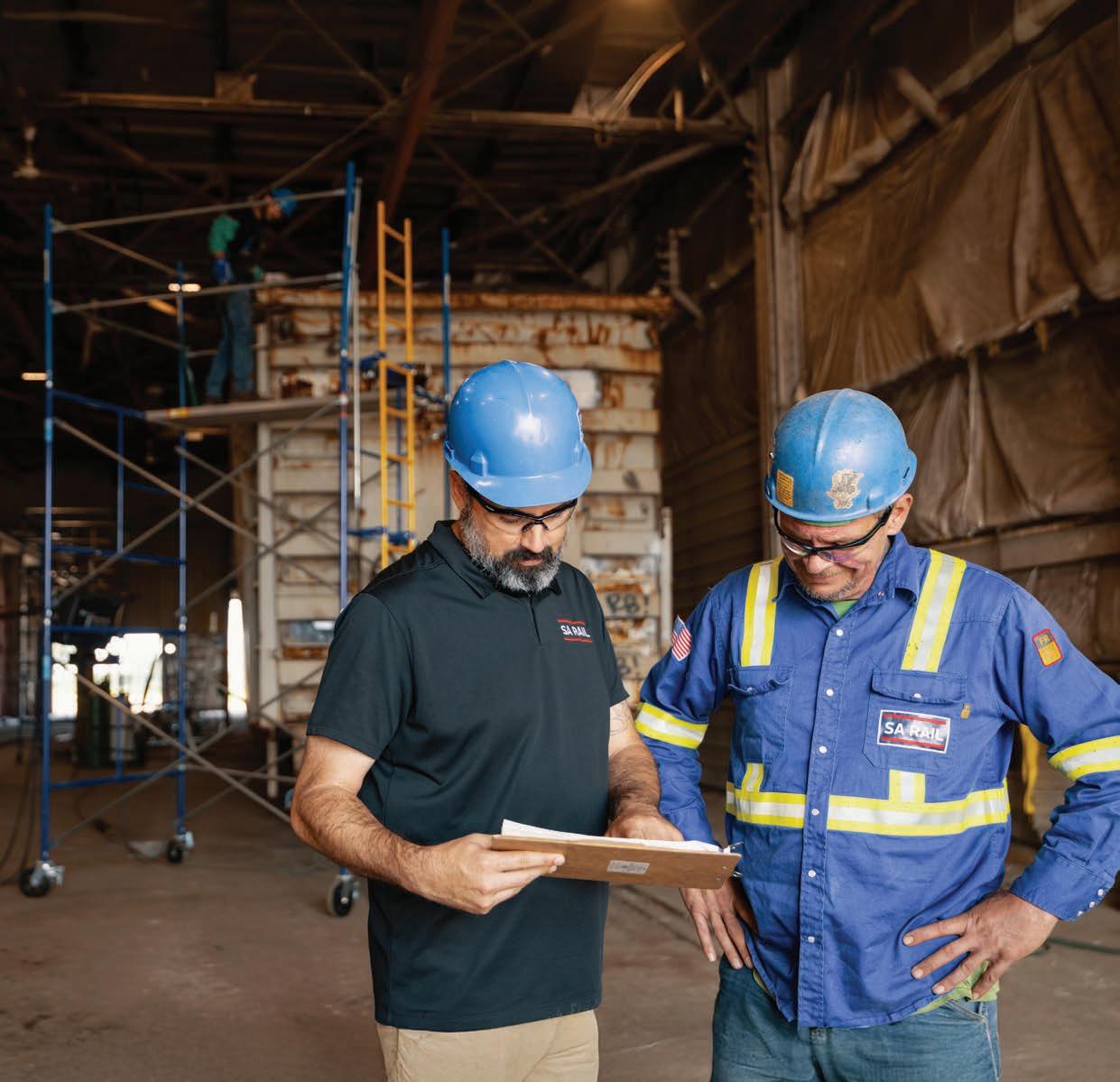
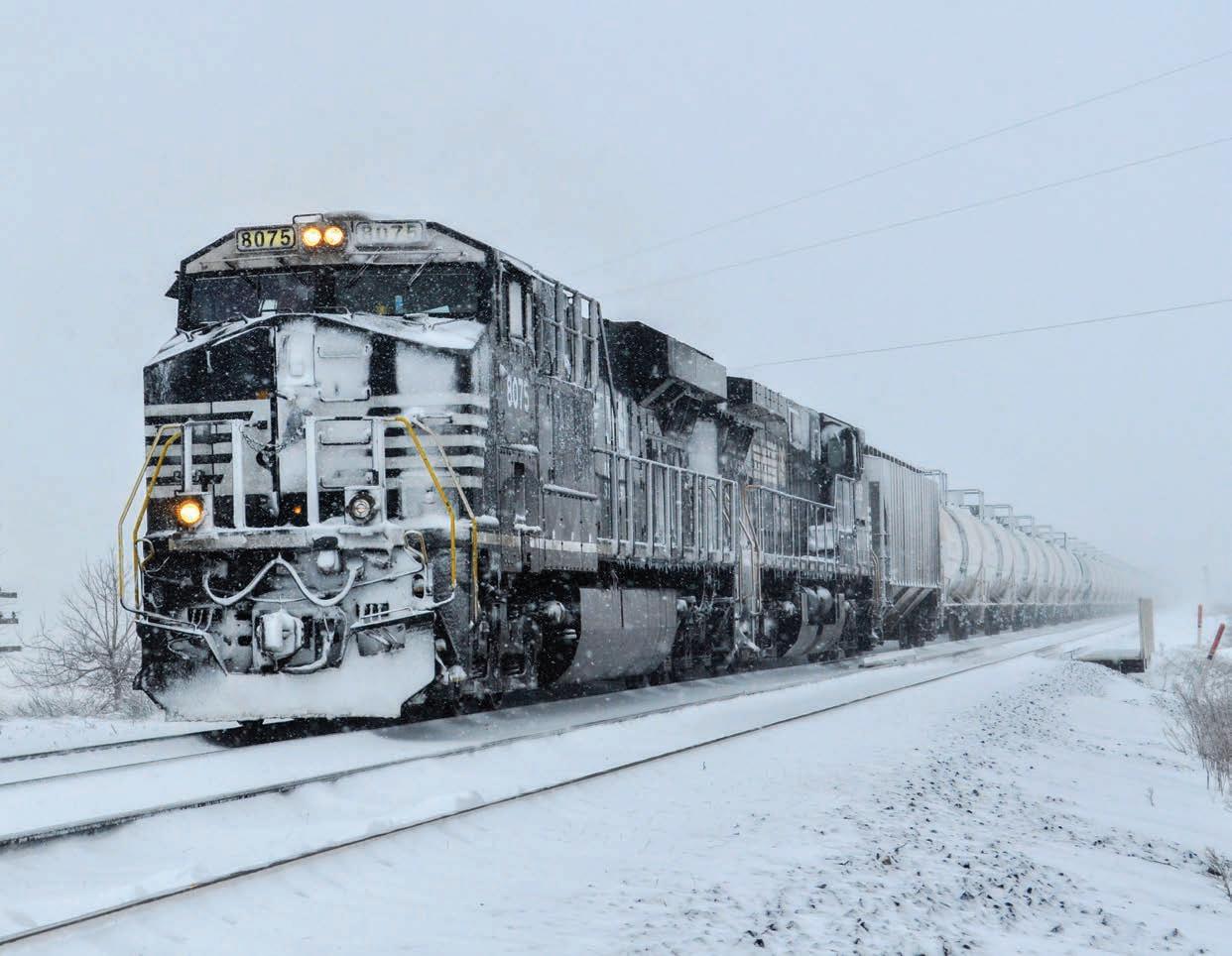
scriptions:
Jim Wolfe: ‘Be Reasonable, Fair and Objective’

The Surface Transportation Board’s fifth member, who will fill the retired Marty Oberman’s seat and on whose appointment blessing of Union Pacific’s marriage with Norfolk Southern (p. 6) will partially rest, is at this writing to be determined. Thus the bright red box (he or she will undoubtedly be a Republican) with a question mark on this month’s “Watching Washington” column (pp. 8-9). But as we were going to press, Frank N. Wilner, our intrepid Capitol Hill Contributing Editor, discovered the most likely choice—and he was more than happy to speak with Railway Age.
He’s James E. Wolfe, 62, a third-generation railroader. “He’s little known publicly, if at all, beyond a small segment of the rail industry, owing to his career efforts to avoid the public eye such as through opinion-page writing and public speaking,” Wilner points out.
“Merger decisions are best made transparently and absolutely free from political interference,” Wilner notes. “Suddenly pivotal at the STB is disciplined, systematic and knowledgeable direction as it prepares to measure the benefits and drawbacks of the largest rail merger in almost three decades. If approved, the marriage will create what even railroad baron John Pierpont Morgan couldn’t accomplish—a truly transcontinental railroad providing seamless Atlantic Coast to Pacific Coast service. As such, essential is a nominee experienced in every aspect of railroading, from the ballast to the C-Suite to the labor negotiating table, and versed in the intent, history and nuances of the STB’s controlling statute. Rather than a grandstander with an agenda, the nominee must
be—and perceived by stakeholders to be— committed to neutrality and able to contribute specialized proficiency.”
Jim Wolfe fits this description to a T-rail. Wilner describes him as “an attorney with in-depth knowledge of commerce law; a working background in freight and passenger rail (Union Pacific, Amtrak, Illinois DOT); first-hand dealing with Congress and Executive Branch agencies; and understanding of official Washington political nuances.”
Between 1997 and 2023, Wolfe, a graduate of Loyola University and DePaul University’s College of Law, was Chairperson and CEO of Chicago-based Knight Engineers and Architects, which focused on aviation, highway and rail infrastructure projects in the public and private sectors. That included serving as the Class I railroads’ lead negotiator for the Chicago CREATE Program.
Why does Jim Wolfe have interest in an STB nomination? “I would like to be part of the process that moves the STB back to its intended legislative purpose of being the economic regulator of freight rail, and not some Orwellian entity that tries to micromanage railroad operations while simultaneously inundating the railroads with burdensome requests for data and never-ending litigation,” he told Wilner. “The STB has a narrow scope—be reasonable, fair and objective. STB members should be neutral, non-biased arbitrators who understand railroads, their customers and competitive markets.”
Amen, I say to you!

WILLIAM C. VANTUONO Editor-in-Chief
Railway Age, descended from the American Rail-Road Journal (1832) and the Western Railroad Gazette (1856) and published under its present name since 1876, is indexed by the Business Periodicals Index and the Engineering Index Service.
Name registered in U.S. Patent Office and Trade Mark Office in Canada. Now indexed in ABI/Inform.
Change of address should reach us six weeks in advance of next issue date. Send both old and new addresses with address label to Subscription Department, Railway Age, PO Box 239, Lincolnshire IL 60069-0239 USA, or call (US, Canada and International) 847-559-7372, Fax +1 (847) 291-4816, e-mail railwayage@omeda.com. Post Office will not forward copies unless you provide extra postage.
POSTMASTER: Send changes of address to: Railway Age, PO Box 239, Lincolnshire, IL 60069-0239, USA.
Photocopy rights: Where necessary, permission is granted by the copyright owner for the libraries and others registered with the Copyright Clearance Center (CCC) to photocopy articles herein for the flat fee of $2.00 per copy of each article. Payment should be sent directly to CCC. Copying for other than
keeping or return of such material.
Member of:
AILWAY GE
SUBSCRIPTIONS: 847-559-7372
EDITORIAL AND EXECUTIVE OFFICES
Simmons-Boardman Publishing Corp. 1809 Capitol Avenue Omaha, NE 68102 (212) 620-7200 www.railwayage.com
ARTHUR J. McGINNIS, Jr. President and Chairman
JONATHAN CHALON Publisher jchalon@sbpub.com
WILLIAM C. VANTUONO Editor-in-Chief wvantuono@sbpub.com
MARYBETH LUCZAK Executive Editor mluczak@sbpub.com
CAROLINA WORRELL Senior Editor cworrell@sbpub.com
DAVID C. LESTER
Engineering Editor/Railway Track & Structures Editor-in-Chief dlester@sbpub.com
JENNIFER McLAWHORN
Managing Editor, RT&S jmclawhorn@sbpub.com
HEATHER ERVIN Ports and Intermodal Editor/Marine Log Editor-in-Chief hervin@sbpub.com
Contributing
Editors
David Peter Alan, Jim Blaze, Nick Blenkey, Sonia Bot, Bob Cantwell, Dan Cupper, Alfred E. Fazio, Justin Franz, Gary Fry, Michael Iden, Don Itzkoff, Bruce Kelly, Joanna Marsh, David Nahass, Jason Seidl, Ron Sucik, David Thomas, Frank N. Wilner
Art Director: Nicole D’Antona Graphic Designer: Hillary Coleman
Corporate Production Director: Mary Conyers
Production Director: Eduardo Castaner
Marketing Director: Erica Hayes Conference Director: Michelle Zolkos Circulation Director: Joann Binz
INTERNATIONAL OFFICES
46 Killigrew Street, Falmouth, Cornwall TR11 3PP, United Kingdom 011-44-1326-313945
International Editors Kevin Smith
ks@railjournal.com
David Briginshaw db@railjournal.com
Robert Preston rp@railjournal.com
Mark Simmons
msimmons@railjournal.com
CUSTOMER SERVICE: RAILWAYAGE@OMEDA.COM , OR CALL 847-559-7372
Reprints: PARS International Corp. 253 West 35th Street 7th Floor
New York, NY 10001
212-221-9595; fax 212-221-9195 curt.ciesinski@parsintl.com
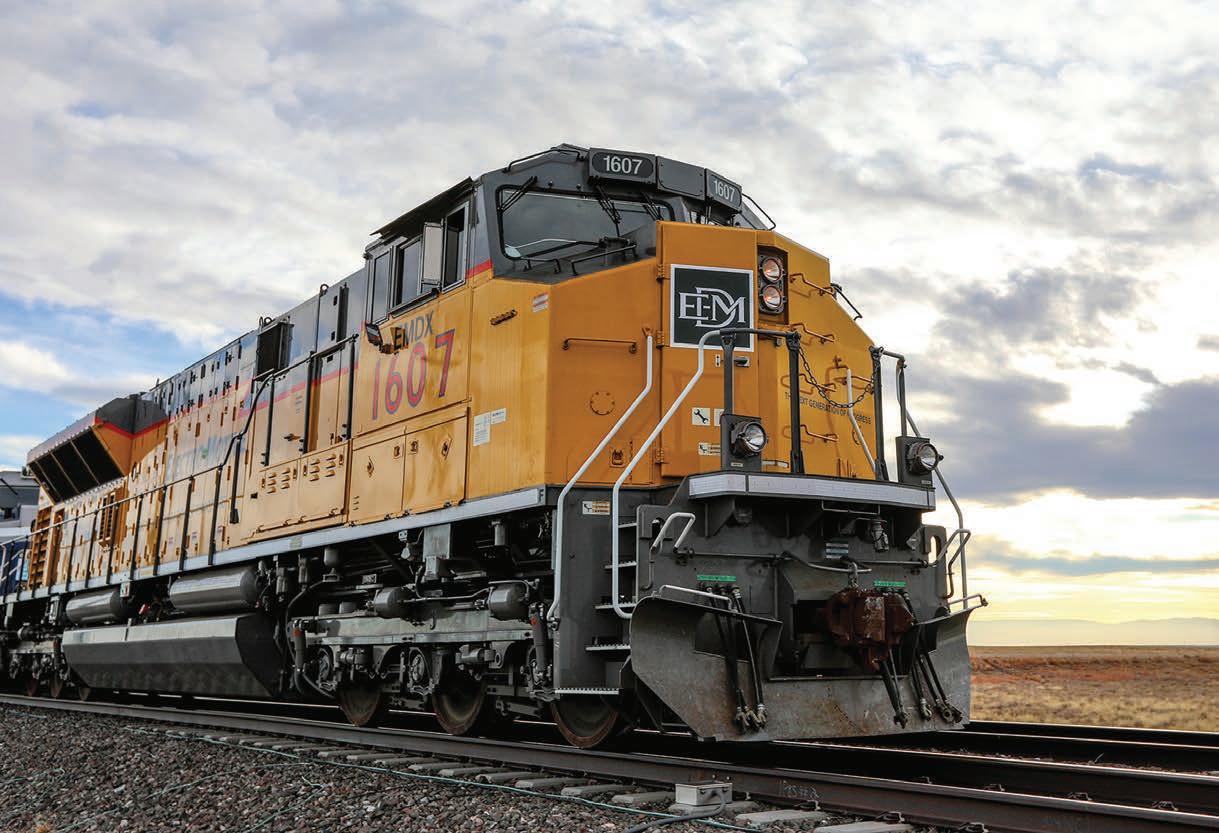

AI that powers Real Results

Talos™ leverages machine learning and arti cial intelligence to create customized strategies for each train’s speci c makeup, managing and optimizing every mile of the journey.
By adapting to train behavior and customer operational objectives, Talos offers higher overall fuel savings up to 25% and equally impressive emissions reductions.
Talos also improves safety by rigorously managing train handling, helping prevent break-in-twos with the best in-train force management in the industry.
Saving fuel, reducing emissions, and improving operational safety — it’s how we keep you rolling.


Talos is integrated into the locomotive operator display. Scan to learn more about Talos.
Industry Indicators
‘CONTINUED UNCERTAINTY ON AND OFF THE RAILS’
“In recent months, the U.S. economy has defied easy characterization, caught between signals of underlying strength and uncertainty regarding the road ahead,” the Association of American Railroads reported last month. “Rail freight volumes have followed that lead, reflecting a mix of cautious optimism and lingering hesitation across key sectors. The uncertainty characterizing both the economy and freight markets is likely to continue because key drivers of economic momentum—including the labor market, consumer spending, inflation levels, interest rates, and economic policies across the globe—remain fluid.”
“U.S. rail intermodal originations fell 2.9% (31,000 containers and trailers) in June 2025 from June 2024, their first year-over-year decline in 22 months. June’s decline comes amid broader uncertainties impacting global supply chains that have tempered international shipments. In June 2025, U.S. rail intermodal volume averaged 260,834 units per week, below the 2016-2005 average for June of 263,991.
“For 2Q25, intermodal was up 2.0% over last year. For the first six months of 2025, U.S. intermodal volume totaled 6.98 million units, up 5.1% (340,000 units) over last year and the third most ever for January to June (behind 2018 and 2021). Looking ahead, intermodal performance will hinge on a range of factors, including developments impacting global supply chains and the strength of consumer-driven freight demand. These trends are always difficult to predict.
“Meanwhile, total U.S. rail carloads (excluding intermodal) rose 2.1% (nearly 19,000 carloads) in June 2025 over June 2024, their fourth straight year-overyear increase—the first time that’s happened since late 2021. In June, 10 of the 20 carload categories tracked by the AAR had year-over-year gains. Total U.S. rail carloads averaged 226,259 per week in June 2025, the most for June since 2021. In the 66 months since January 2020, only 14 months had a higher weekly average than June 2025 did.
“Total carloads were up 4.8% in 2Q25 over 2Q24, their biggest quarterly percentage gain since 3Q21. In the first half of 2025, total carloads were up 2.4%, or 136,000 carloads, over last year.
“The AAR Freight Rail Index (FRI), a gauge of seasonally adjusted rail volumes excluding coal and grain, fell 0.5% from May 2025 to June 2025, bringing the index to its lowest point since May 2024. June’s decline mainly reflects intermodal softness. Seasonally adjusted carloads excluding coal and grain and excluding intermodal rose 0.7% in June from May, reflecting pockets of strength for certain key rail sectors amid current economic uncertainties.
“The first half of 2025 offered few clear signals, and the months ahead may be no different. Freight volumes, like the broader economy, will likely continue to reflect a mix of competing forces—some supportive, others restraining—as businesses and consumers navigate an unsettled economic landscape.”





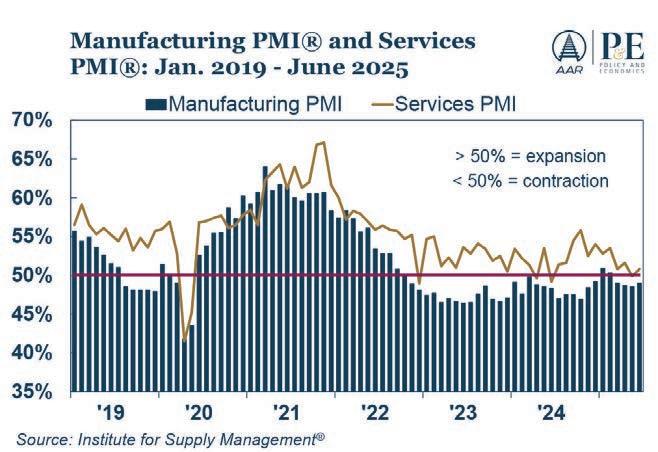

Industry Outlook
Norfolk Southern + Union Pacific: It’s Official

THE SPECULATION IS OVER: UNION PACIFIC AND NORFOLK SOUTHERN ON JULY 29 ANNOUNCED THEIR AGREEMENT TO, IN A COMBINED CASH AND STOCK TRANSACTION VALUED AT MORE THAN $250 BILLION, MERGE AND CREATE THE FIRST U.S. TRANSCONTINENTAL RAILROAD. UP is the acquiring company. Under the terms of the agreement, UP will acquire NS in a stock and cash transaction. NS shareholders will receive, for every share of NS stock, one share of UP stock plus $88.85 in cash, “implying a value for NS of $320 per share based on UP’s unaffected closing stock price on July 16, 2025, and representing a 25% premium to NS’s trading day volume weighted average price on July 16, 2025,” both railroads stated. “The value per share implies an enterprise value of $85 billion for NS, resulting in the creation of a combined enterprise of more than $250 billion.”
UP will issue a total of approximately 225 million shares to NS shareholders, “representing 27% ownership in the combined company on a fully diluted basis, and providing the ability of NS shareholders to participate in the upside of the combined company’s growth opportunities and synergies. The agreement is structured without a voting trust and includes a $2.5 billion reverse termination fee. The cash portion of the transaction will be funded through a combination of new debt and balance sheet cash. At closing, the combined
business will have a strong balance sheet and Debt to EBITDA of approximately 3.3x, supporting a balanced capital allocation strategy. The combined company will continue to prioritize and maintain a strong balance sheet and investment grade rating. Based on 2024 results, the pro-forma combined company would have revenues of approximately $36 billion, EBITDA of approximately $18 billion, operating ratio of 62%, and free cash flow of $7 billion. The transaction is expected to be accretive to UP’s adjusted EPS per share in the second full year after closing and rising to high single digit accretion thereafter.” As well, both companies will suspend share repurchases but will continue to pay dividends.
The transaction, expected to be filed with the Surface Transportation Board within six months, undergo a 15-month review process and close by early 2027, is “expected to unlock approximately $2.75 billion in annualized synergies and deliver substantial long-term value for UP and NS shareholders,” the Class I’s said. The combined company will be headquartered in Omaha, Neb. Atlanta, Ga., “will remain a core location for the combined organization over the long-term with a focus on technology, operations, and innovation, among other priorities.”
Jim Vena, UP CEO (top, at left), will be CEO of the combined company, dubbed the “Union Pacific Transcontinental Railroad,” and “has committed his intent to remain at
UP for at least the next five years,” UP and NS noted. “Through integration and beyond, talented leaders from both companies will work together to deliver on the combination’s full value creation potential. The experienced UP and NS management teams will continue to independently run each company until the transaction’s closing.” At closing, three NS Directors, including Mark George and Richard Anderson, are expected to join the UP Board of Directors after completing the corporate governance process.
Vena and George acknowledged that combining the two companies “will not be easy,” but that their cultures “are closely aligned” and that both will continue to operate “without distraction.”
“These legendary companies will seamlessly connect more than 50,000 route-miles across 43 states from the East Coast to the West Coast, linking approximately 100 ports and nearly every corner of North America,” UP and NS said. “This combination will transform the U.S. supply chain, unleash the industrial strength of American manufacturing, and create new sources of economic growth and workforce opportunity that preserves union jobs. Together, [we] aim to be the safest railroad in North America and deliver the service customers rely on with operational excellence. The combined company will deliver faster, more comprehensive freight service to U.S. shippers by eliminating interchange delays, opening new routes, expanding intermodal services, and reducing distance and transit time on key rail corridors. A more truck-competitive solution, the Union Pacific Transcontinental Railroad will decrease highway congestion, reducing wear-and-tear on taxpayer-funded roads.”
Will the Norfolk Southern name and iconic “Thoroughbred” prancing horse logo on a black locomotive carbody fade into history as another fallen flag—just like all prior UP acquisitions (Missouri Pacific, Western Pacific, Missouri–Kansas–Texas, Chicago, Rock Island & Pacific, Chicago & North Western, Southern Pacific)? In a joint interview with Mark George, Jim Vena said it will not. That remains to be seen. – William C. Vantuono
Rail Equipment Call: Decision Paralysis Continues

TD Cowen recently hosted a call with industry executives from the rail equipment market. From that, we heard order books are seeing no notable growth, attributable to tariff uncertainty, and used car valuations are increasing. Bonus depreciation likely won’t be an incremental driver of rail equipment demand. Consolidated rail service hasn’t seen improvements despite Class I emphasis.
Tariff uncertainty continues to pressure the order book. Railcar end users are unwilling to make capital decisions due to volatile policy, and the second quarter is expected to be on par or slightly below weak first-quarter levels. The inquiry-to-order conversion rate remains weak, and panelists noted that railcar users need six to seven months of forecast clarity to justify the capex. While panelists are seeing speculative purchases up slightly, the bulk of ordering activity is replacement or linked to new plants. Bonus depreciation in the tax bill is likely not a big driver of incremental demand for rail equipment. Interest rates play a much more significant factor for purchase decisions; our panelists believe that if we get tariff clarity along with other tailwinds (bonus dep, rate cuts), then this should drive demand for rail equipment, but tax bill on its own is not a needle mover. Rail service has been a shallow roller coaster, and one panelist (who surveyed 29 terminals) saw terminal dwell worsen sequentially in the second quarter. June was not any better than May, according to our panelist who looked at terminals on both the East and West coasts. Certain carriers on each coast have performed marginally better than their competitor, though there have been no noteworthy service improvements despite Class I emphasizing its importance in recent quarters.
Used car valuations are elevated despite the relatively tepid demand picture. Inflation in manufacturing input costs for new cars has led railcar customers to the used market. One panelist attested to a 30%-45% increase in the cost of five-year assets. While lease rates are fairly reasonable (down slightly) at this time according to panelists, used price surge and consolidation in the lessor fleet could result in upward pricing pressure in the future (the GATX wells fleet now accounts for approximately 25% of the aggregate lessor fleet).
Panelists discussed the various channels through which a transcontinental rail merger could impact the equipment market. Merger-driven carload growth enabled by fewer interchanges would support increased equipment demand in the long term. Near-term service impacts resulting from recalibrating the network could also support intermittent equipment demand. However, longer term, fluidity and efficiencies would likely allow the railroads to do more with less equipment. It is too early to tell how these puts and takes would net out. – Jason Seidl, Elliot Alper and Uday Khanapurkar, TD Cowen
NEW JERSEY TRANSIT last month released a Request for Qualifications (RFQ) for special prequalification for the final design, construction, and commissioning of the Northern Rail Maintenance-of-Way Facility, a major infrastructure initiative located in Clifton, N.J. According to the agency, the new facility will replace the “aging and floodprone” Wood-Ridge location, “creating a more resilient and modernized base of operations to support NJT’s growing maintenance and repair needs. It will enhance NJT’s ability to maintain the right-of-way and railroad infrastructure by providing modernized space for maintenance, servicing and repair of vehicles. The design will enhance the current functions performed at the existing facility, accommodate increased maintenance
demands and incorporate updated features that meet current codes and operational needs.” The project includes demolition and environmental abatement of an existing building and substructures at 99 Kuller Road; construction of three new buildings across two NJT-owned sites; site grading, new access roads and dedicated parking areas; and coordination of site utilities and integration of maintenance equipment. The special prequalification process will evaluate design-build teams based on their technical qualifications, relevant experience and project approach, the agency noted. Following the evaluation, NJT says it anticipates shortlisting the most qualified firms to move forward to the next phase. At that point, a formal Request for Proposal (RFP) will be issued.
WABTEC and INTERMODAL TELEMAT-
ICS B.V. (IMT), a Dutch-based rail telematics technology company, last month entered into an agreement that allows Wabtec to be the exclusive distributor of IMT’s telematics solutions for railcars in the major European freight markets. This agreement “leverages IMT’s technology and Wabtec’s presence to deliver smart, connected railcar solutions across Europe. It is a step forward in the Wabtec’s digital transformation strategy, aimed at providing fully integrated, data-driven solutions that optimize rail operations. By combining IMT’s telematics expertise with Wabtec’s in-depth knowledge of braking systems and rail technology, the two companies will offer their customers smarter maintenance, enhanced safety and improved operational efficiency.”
Watching Washington
Union Pacific + Norfolk Southern: What Comes Next?
Following weeks of “perhapses,” “maybes,” and a “conceivably” or two—self-serving bait for valuable feedback—railroads Union Pacific (UP) and Norfolk Southern (NS) have officially announced merger plans (p. 6).
BNSF and CSX have yet to signal a defensive strategy. And how CN—which previously stood outside the chapel watching rival Canadian Pacific (CP) wed Kansas City Southern (KCS)—reacts is another mystery. Not to be ignored is a rich history of “inconsistent merger applications,” by which snubbed brides ask the rail regulator—Surface Transportation Board (STB) in this instance—to order a menage-a-trois as a condition of the primary merger. That could occur with UP-NS or, if it occurs, BNSF-CSX.
Although the STB has exclusive authority under the law to approve or reject a railroad merger application, the law directs STB to “accord substantial weight” to comments of the Department of Justice’s Antitrust Division (DOJ).
It could be two years before the stereotypical fat lady sings as numerous pre-merger formalities must first be satisfied. Once the STB accepts a formal merger application, it has 15 months for evidence gathering and deliberation before issuing a final “yes” or “no”—unlikely before mid- or late-2027. (For more information on railroad mergers, visit the Merger Resources quick link on the STB website.)
An early problematic hurdle is avoided by the absence of a voting trust under which shares of the railroad to be “acquired” are placed with a neutral trustee, permitting the two railroads to operate independently while awaiting an STB decision on the merger application.
In 2016, when CP sought to acquire NS, DOJ said it had “serious competitive concerns” with the voting trust—the deal voluntarily scuttled ahead of STB deciding. In 2021, STB’s rejection of a voting trust derailed a CN-KCS merger attempt. The STB did, however, approve a voting trust ahead of the CPKC merger.
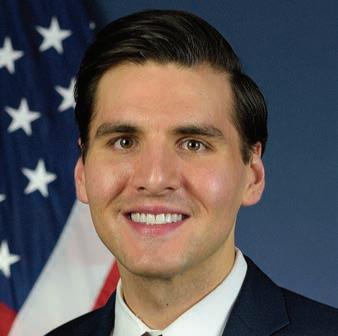

Handicappers’ Guide
If you wager on who votes how, consider: Chairperson and Republican Patrick J. Fuchs, 37, serving a second term expiring Jan. 14, 2029, is self-committed to “transparency,” to “follow the law” and assuring captive shippers “have access to markets on reasonable terms.” Coupling that to a voting record favorable and unfavorable to railroads, suggests he has no agenda—and is unlikely to adopt one given his relative youth and importance of preserving future opportunities in the public or private sector.
Republican Michelle A. Schultz, 53, whose first term expires Jan. 11, 2026, will require, if she is to cast a vote in 2027, a second nomination by POTUS 47 (who nominated her during his first term) plus Senate confirmation. Said to have a “cautious approach” to matters of first impression, Schultz has been in lockstep with Fuchs—for independent reasons and not political or “me-too,” say sources. She recently recommended, following listening sessions with attorneys practicing before the STB, a streamlining of processes and procedures to speed decision making.
Democrat Robert E. Primus, 55, is in his second and final (by statute) term that expires Dec. 31, 2027. He has had testy exchanges with rail CEOs, but a cordial one over service and operational issues with UP CEO Jim Vena. Primus’ thumb is perceived on the scales in favor of rail labor and against carrier harmonizing of headcounts based on
productivity improvements. At a rail labor gathering, he said, “Thank you for letting me represent you.” Primus, the lone “no” vote when the CPKC merger was approved in 2023, cited market-power concentration and concern that mergers “degrade working conditions, depress wages and impair or eliminate organized labor.”
Democrat Karen J. Hedlund, 77, whose first term expires Dec. 31, 2025, will require renomination by POTUS 47 (her first was by President Biden) and Senate confirmation if she is to cast a vote in 2027. She may consider retirement, but if a merger filing is made—merger decisions among the most significant of STB responsibilities—she might seek a second term. When recently asked about a rail merger, Hedlund said, “Bring it on.”
A fifth seat (to fill former Chairperson Martin J. Oberman’s vacancy) is open for a Republican nominee. There is no evidence POTUS 47—pro-business and anti-regulation—has an opinion on rail mergers. The Heritage Foundation-produced Project 2025, which POTUS 47 has followed closely, makes no mention of the STB or rail mergers.
Presidential politics still matters, as the STB chairperson serves at the President’s invitation and the President chooses nominees.
Notable is that few corporations are as closely aligned with Republican administrations. Ronald Reagan’s Transportation Secretary Drew Lewis became UP
Patrick J. Fuchs
Michelle A. Schultz
Watching Washington

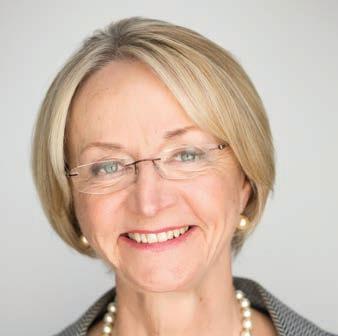
chairperson and CEO. Andrew Card was George H.W. Bush’s Transportation Secretary and then George W. Bush’s chief of staff before becoming a UP Board member—as did Vice President Dick Cheney. A UP “funeral train” transported the casket of the elder Bush from Houston to College Station, Tex., for burial in 2018.
This balances against a current thinskinned President whose loyalty to others is transactional and never enduring. George H.W. and son George W. Bush were harshly evaluative of POTUS 47’s first term (20172021). George W. Bush neither endorsed nor supported POTUS 47’s 2024 reelection. Cheney publicly endorsed POTUS 47 opponent Kamala Harris. Well documented is that POTUS 47 does not forget slights.
Nonetheless, there appears no justification to presume STB Republican members are under White House pressure to vote other than as the evidence leads them independently.
New Merger Rules
Should the now announced UP-NS merger intent advance to a formal merger application before the STB, it will be the first decided under New Merger Rules adopted by the agency in 2001. The CPKC transaction was decided under an exception to those rules owing to KCS’s small size relative to other Class I railroads—the STB in 2001 saying a KCS transaction would “not necessarily raise the same concerns and risks as other
potential mergers between Class I railroads.”
The New Merger Rules increase applicant burdens to demonstrate the transaction is in the public interest and enhance—not simply preserve—competition. Said the STB in 2001:
“While further consolidation of the few remaining Class I carriers could result in efficiency gains and improved service, the Board believes additional consolidation in the industry is also likely to result in a number of anticompetitive effects, such as loss of geographic competition, that are increasingly difficult to remedy directly or proportionately. Offering some new or enhanced rail-to-rail competition or other competitive benefits is likely to be necessary to resolve substantial difficulties to tip the balance in favor of the public interest.”
CSX and NS, which in 1998 gained STB approval for joint acquisition of Conrail, later termed the 2001 New Merger Rules “apparent antagonism toward mergers.”
Competition enhancements might include constructing choke point bypass routes around Chicago and St. Louis; allowing segment rates where bottlenecks exist; offering reciprocal switching and trackage and traffic rights (the latter permitting freight solicitation); and demonstrating how train speeds will increase and terminal dwell times will improve. Advances in driverless trucks make cost savings and efficiencies from merger-created single-line service essential to improving the railroads’ competitive
position, as intermodal growth increasingly is essential to railroad financial health.
The New Merger Rules also require an assessment of “downstream effects.” Most obvious are responsive mergers creating an east-west transcontinental duopoly, although such already exists regionally (and in Canada). Also to be provided is a “service assurance plan” to cure unexpected hiccups during the merger transition.
Is the STB prepared? While its fiscal year 2026 budget request of $40.8 million is a $7 million cut, Fuchs cites cost savings from eliminating “wasteful” contracts, not filling attrition-created “non-core” vacancies, plans to implement artificial intelligence for repetitive tasks, and clearing out long-inlimbo cases.
Railway Age Capitol Hill Contributing Editor Frank N. Wilner was a White House appointed chief of staff to Republican STB member Gus Owen when the 1996 UP-Southern Pacific merger was approved. He is author of Railroads & Economic Regulation,” available from Simmons-Boardman Books, 800-228-9670.


FRANK N. WILNER
Capitol Hill
Contributing Editor
Robert E. Primus
Karen J. Hedlund
To Be Determined
Organic Growth or Doing More With Less?
Statistics indicate that married couples are better savers and do better financially than single people. It’s not over most married couples’ natural propensity to nest vs. the go-go life of a swinging single. Two people sharing one set of common expenses is more cost-effective and efficient than a single household. According to The Wall Street Journal, the median net worth of married couples between the ages of 25 and 34 is nine times that of similarly aged single households. That frees up more capital for fun (vacations and nice cars) and savings and therefore leads to the perception of a better quality of life. This is not true just for people, but for corporations as well.
The announcement that Union Pacific intends to acquire Norfolk Southern (p. 6) wasn’t the most surprising news wire in 2025. (That might be that the museum commemorating the great Johnstown, Pa., floods was closed due to … wait for it … flooding.) The buzz surrounding a possible transcontinental railroad merger was quite intense. UP’s initial announcement that it was in “advanced discussions” with NS could have been a product of confirmation bias, but more likely it was a response to a Presidential Administration that seems friendly to some kinds of business.
Jason Seidl, Wall Street Contributing Editor for Railway Age, noted that UP was reading the politics in the room and that this overture felt serious. Seidl said that UP was expecting the fifth STB board member to support a merger and that the railroad hired an investment bank to assist in the evaluation. He was correct! As long-time Financial Edge columnist Tony Kruglinski often said, “If they’re spending money, then I know they’re serious.”
It had become difficult to pick up any state of the rails summary that didn’t discuss the possibility of a transcontinental merger. Some were surprised by the target of NS over CSX, but that was just noise. The real news is that if the six Class I’s become five, how long will it be before there are four or even three?
In a similar yet completely different vein, in mid-June, GATX announced an acquisition of Wells Fargo Rail in
conjunction with Brookfield Asset Management. Over a period of ten years, GATX will have the option to acquire almost 100% of the Wells Fargo Rail fleet. This will make GATX the largest operating lessor of railcars and locomotives in North America and give them control/ ownership of 23% of the operating lessorowned railcar fleet.
Railcar operating lessor consolidation has been on a low simmer over the past decade. Some of the impetus has been a private equity infusion (directly or indirectly) into the railcar market; some has been the recognition that railcar prices (and rental rates for leasing cars) hadn’t exactly kept up with inflation.
After this transaction, there will be five railcar operating lessors with more than 100,000 cars, a couple with fewer than 100,000 and more than 20,000, and a larger group with 20,000 or fewer.
Here’s the point: North American rail is an incredibly mature industry that runs fluidly (more or less) over a continent. The industry frets and frets and frets again and again over growth. Mergers and acquisitions at lofty levels between some of the largest companies in a segment is about expense consolidation and reduction, efficiency and of doing more with less. It is rarely about increased prospects for organic growth.
Some people can convince (or con) themselves that a transcontinental railroad will provide better service. A railroad that can move intermodal across the country and avoid the Chicago interchange can be better at moving that freight. Ask most shippers what generally offers them better service and most would say having two railroads compete for the same business. Mergers promise improvements. North American rail hasn’t always delivered on those promises.
Mergers at these levels seem almost defensive as well as opportunistic. Like a married couple, the sum of two may deliver better financial reports together than separately.
Key differences between the mergers exist: A new railroad is not going to appear anytime soon. Generally, the existing
It has been difficult to pick up any summary that didn’t discuss a transcontinental merger. Some may be surprised by Union Pacific’s target of norfolk southern over CSX, but that is just noise. The real news is that if the six Class I’s become five, how long will it be before there are four or even three?”
track is all the track there is going to be. Railcar leasing is different than running a railroad. Even if the industry only intends to produce about 30,000 railcars in 2025, new railcars are easier to manufacture than new lines of track. Lessor consolidation at these levels can allow new entrants into the market that could steal market share from larger companies.
Both deals amplify the ubiquitous concerns about growth that have been and will continue to dominate the rail industry news cycle..
Got questions? Set them free at dnahass@ railfin.com.


DAVID NAHASS President Railroad
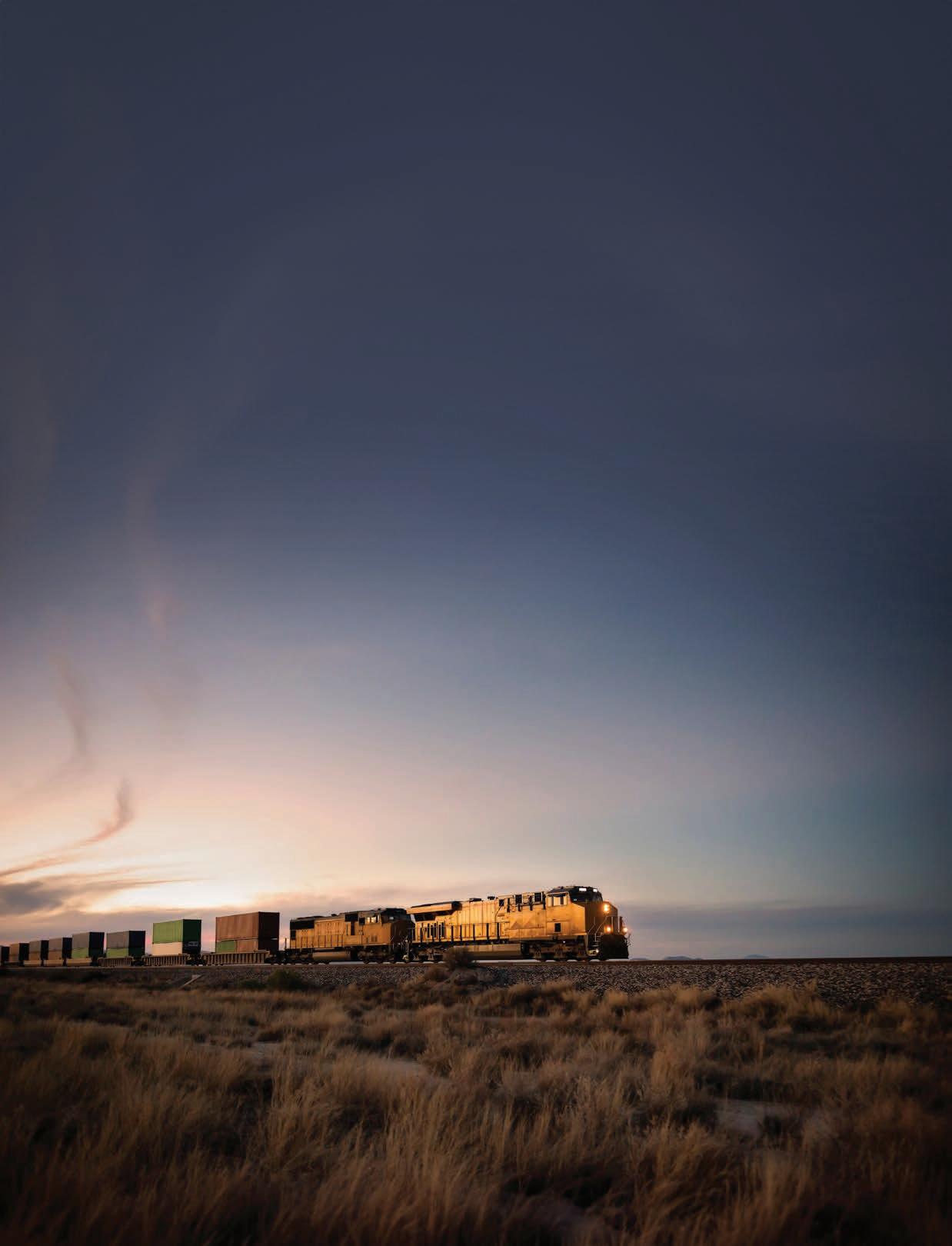
DEDICATED TO KEEPING YOUR WORLD MOVING.
For over 100 years, A. Stucki has been a driving force in the global railroad industry. We’re not just a manufacturer of parts we’re a trusted partner, providing comprehensive solutions to keep our nation’s railways safe, efficient, and reliable.
From humble beginnings as a small foundry, we’ve grown into a diverse company with expertise in every aspect of railroading. We design, manufacture, and supply a wide range of products from critical freight car components to innovative draft and braking systems.

Freight Car and Locomotive Parts
Our engineered solutions ensure that your fleet operates at peak reliability and meets the highest industry standards. Our product offering encompasses a complete range of rail car components to support the full spectrum of rail operations.
Maintenance of Way
Our single-source solution for a wide variety of maintenance needs includes essential track materials to specialized equipment. Our focus on both product excellence and customer support solidifies our position as a reliable partner in maintaining and improving railroad infrastructure.
Repair & Reconditioning Services
Our reconditioning and repair services help save money by prolonging the life of your essential rail components through expert maintenance and repurposing. By maximizing your investments and minimizing downtime, we keep your railcars rolling.
Engineering & Manufacturing
Our state-of-the-art facilities combine precision engineering with advanced manufacturing capabilities to deliver bespoke solutions and components that exceed expectations. We leverage cutting-edge technology to ensure exceptional quality and reliability.
LIGHT RAIL 2025
PRESENTED BY RAILWAY AGE AND RT&S
PLANNING, ENGINEERING AND OPERATIONS
OCTOBER 1 & 2
Fairmont Pittsburgh Pittsburgh, PA
Light Rail 2025 delivers a focused, in-depth look at the technical, environmental, and socio-economic challenges of planning and operating light rail transit (LRT) systems in today’s urban environments.
Who Should Attend Professionals in LRT planning, operations, civil and systems engineering, vehicle technology, and signaling.
Program Content Includes
• Major New-Builds and System Expansions
• Capital Program Management
• Extreme Weather Events: Planning and Mitigation
• Innovations in Rider Experience
• Alternative Propulsion Technologies
• Special Regional Tour
Connect with LRT professionals from around North America—register by 8/22 to save!
Speakers Include

Andy Lukaszewicz Deputy Chief Officer Rail Ops Pittsburgh Regional Transit
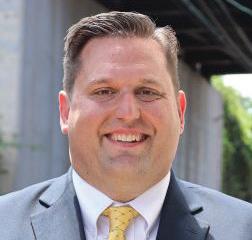
Casey Blaze Deputy Project Mgr.
Greater Cleveland Regional Transit Auth

Ida Posner COO Railroad Development Corp.

Justin Selepack Dir., Railcar Maintenance Pittsburgh Regional Transit

Nate Asplund President Pop-Up Metro, LLC

Rachel Burckardt, P.E. SVP/Sr. Project Mgr., Northeast Lead WSP USA
SPONSORS




Bryan K. Moore Project Mgr., Railcar Replacement Program
Greater Cleveland Regional Transit Auth.
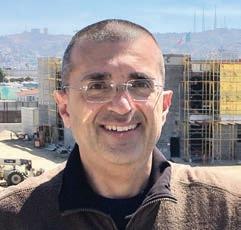
John Mardente Civil Engineer, Passenger Rail Div. Federal Railroad Administration

Barbara M. Schroeder, P.E., P.M.P. Rail Transit Project Manager Benesch

annual winter prep report
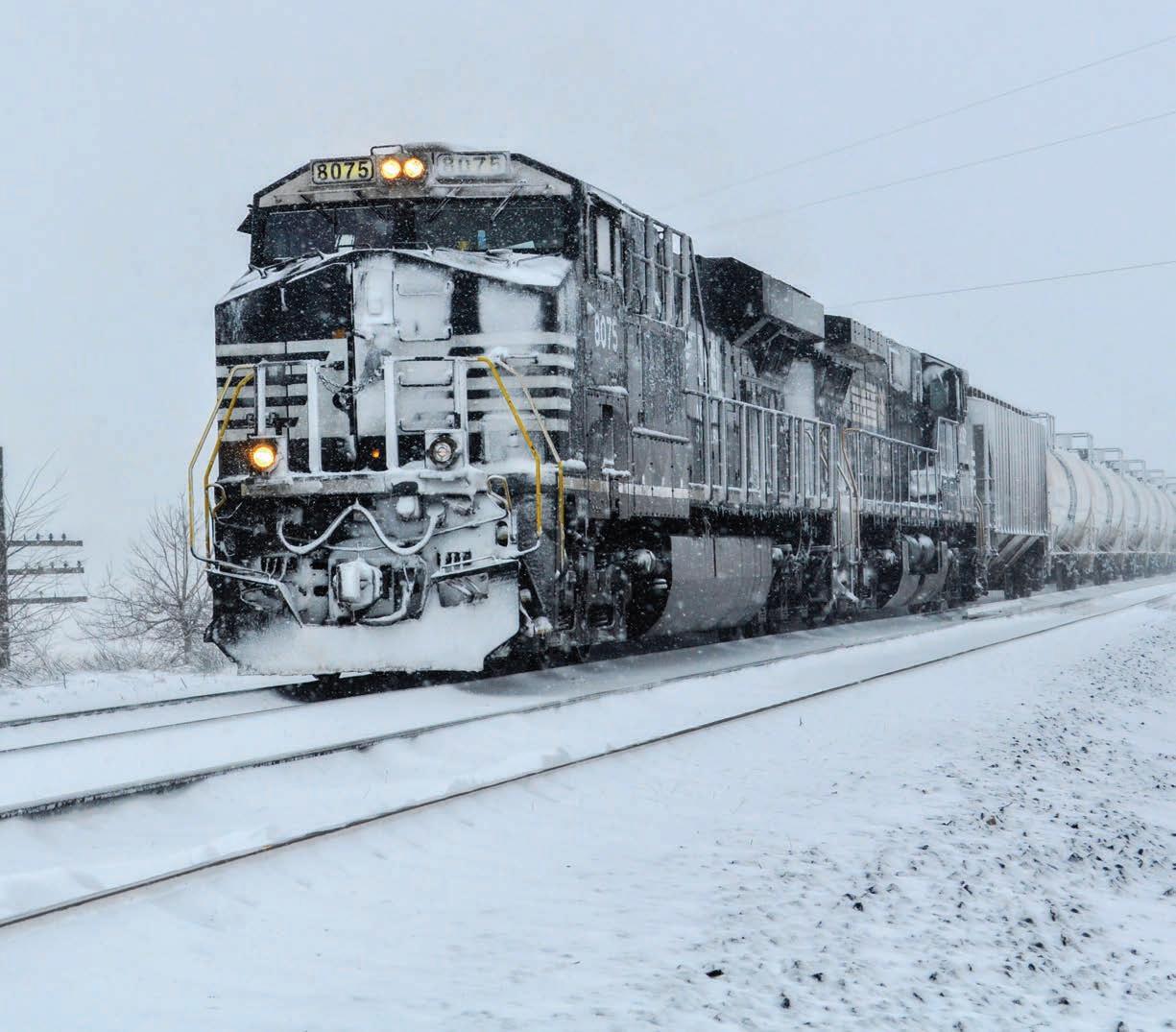
Norfolk Southern works closely with its Class I peers to coordinate traffic flows and share resources during major winter events.
WARM-UP WINTER WEATHER
Railroads and suppliers use innovative technologies to counter the effects of sub-zero temperatures.
BY CAROLINA WORRELL, SENIOR EDITOR
Railroads are vulnerable to extreme weather conditions, and they need to prepare for winter’s onslaught well before operations and the flow of goods are affected. Innovative technologies are needed in critical areas of train operation and functionality. Several railroads and suppliers share with Railway Age how they ready themselves for sub-zero temperatures.
CANADIAN PACIFIC KANSAS CITY
“We pioneered railroading in the harsh Canadian winter,” CPKC tells Railway Age.
“Challenging weather conditions can have a significant impact on railway operations. Each year, across our North American network, we plan for the challenges associated with railroading in extreme weather to mitigate the impacts to the extent possible so that we can continue delivering for our customers.”
As part of CPKC’s winter weather contingency planning, the Class I analyzes weather data and meteorological models to forecast the type, severity, and geographical scope of anticipated winter conditions. While weather forecasts are not exact, they guide critical preparation efforts, CPKC noted. Winter plans are developed for each region,
rail yard, and facility across the network, while assets and resources such as snow removal equipment and sand are strategically placed to facilitate rapid responses to winter weather. Contingency plans also address Operations, Engineering, Mechanical, and Operations Center personnel.
“CPKC prioritizes winter preparedness to mitigate the significant challenges extreme weather poses to railway operations. Operational adjustments, such as implementing shorter train lengths in certain conditions, are required to maintain safety, which always must be the priority,” the Class I said. CPKC says it continues to invest in the people, equipment, and
Norfolk Southern
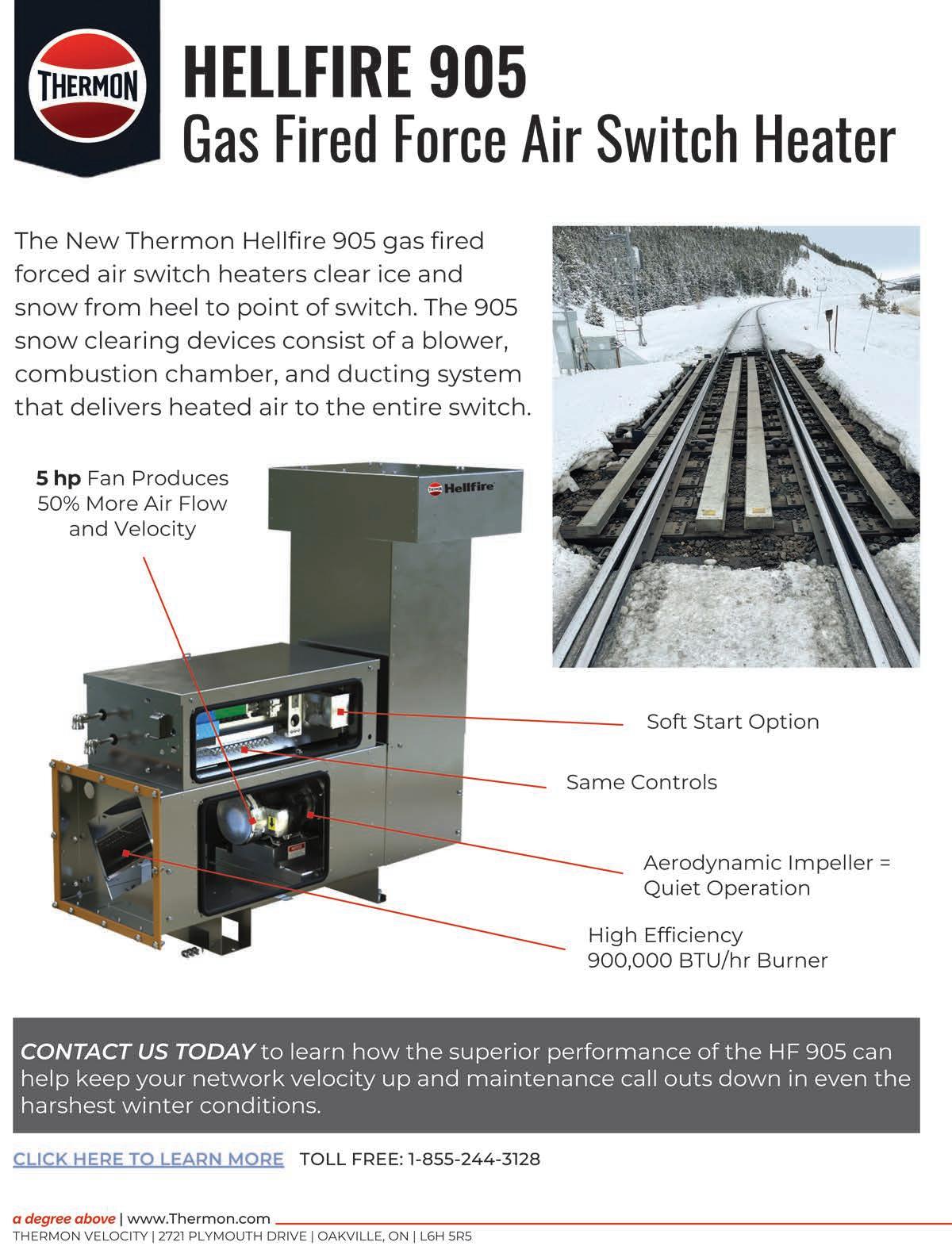
ANNUAL WINTER PREP REPORT
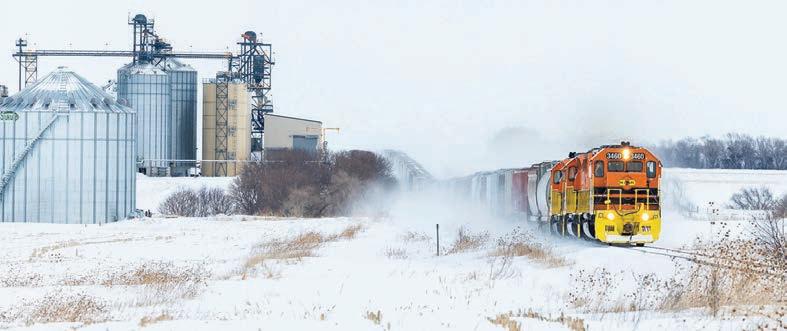
infrastructure needed to safely and efficiently transport traffic throughout the winter and all other seasons. For example, this year, CPKC is taking delivery of 100 new Tier 4 locomotives.
“Collaboration with customers complements these efforts by preparing facilities for winter weather. Safety here remains a cornerstone, with measures like snow and ice removal prioritized throughout the rail network.”
CSX
The CSX winter readiness strategy is a coordinated effort led by the Class I’s engineering and mechanical teams with a strong focus on employee and operational safety, CSX tells Railway Age. As winter weather can pose operational challenges for the transportation industry, CSX takes a proactive approach to seasonal preparedness to ensure its network remains resilient and safe.
This, CSX says, includes ensuring employees are ready for cold-weather conditions, aware of emergency procedures, and equipped with the proper personal protective equipment, such as boot spikes and thermal gear. Walking paths are routinely inspected for hidden hazards, and salt is strategically placed to mitigate slips and falls.
Rail infrastructure is inspected and winterized, and key assets like switch heaters, snow blowers, and generators are tested and staged for rapid deployment. During the spring and summer months, switch heaters are upgraded, and new heaters are installed at additional locations. This year, CSX installed more than 30 new heaters across its network in high traffic locations like Chicago, Indianapolis, Cincinnati, Louisville, and Philadelphia.
CSX’s preparedness strategy also includes exploring innovations that enhance winter operations, the Class I said. “We leverage advanced technologies, including dual electric and propane switch heaters, to effectively reduce
weather-related disruptions. CSX works closely with our customers and other railroads to coordinate traffic flows and maintain fluidity across our network during peak winter conditions.”
NORFOLK SOUTHERN
“As a Class I railroad, we know that winter weather can pose serious challenges to our operations. That’s why we take a proactive, systemwide approach that begins in the summer to ensure we’re ready to keep freight moving safely and efficiently—even in the harshest winter conditions,” NS tells Railway Age
“We install and maintain switch heaters across our network to prevent ice and snow from freezing critical track components. In areas prone to drifting snow, we use snow fences and windbreaks to reduce accumulation. We also prioritize drainage maintenance to prevent flooding and ice buildup from snowmelt.
“Our mechanical teams work ahead of the season to winterize locomotives and railcars. That includes inspecting and insulating air brake systems, using fuel additives to prevent gelling, and ensuring batteries and electrical systems are cold-weather ready. We also conduct cold weather testing on new equipment to ensure it performs reliably in extreme conditions.
“We use remote sensors to monitor track temperature, rail stress, and switch status in real time. In some areas, we deploy drones to inspect hard-to-reach or snow-covered infrastructure. Our predictive analytics tools (DTI portals and ATGMS technology) help us anticipate weather impacts and adjust operations before disruptions occur.
“When temperatures drop, we may shorten train lengths or adjust speeds to reduce the risk of break-apart. We also pre-stage snow removal equipment and mobile response teams in highrisk areas. Our dispatchers use contingency routing plans to reroute traffic around blocked
or congested corridors.
“We work closely with our Class I peers to coordinate traffic flows and share resources during major winter events. Through joint dispatch centers and data-sharing platforms, we stay aligned and responsive across the broader rail network.”
GENESEE & WYOMING
Winter preparedness across G&W’s U.S. railroads most impacted by winter weather (namely those in the Northeast and upper Midwest, as well as through South Dakota, Kansas, and Utah) begins in late summer/early fall with the following activities:
• Conduct industry audits to ensure the ground is free of debris that snow would otherwise cover up and cause a hazard.
• Pre-order supplies such as switch brooms, winter boots, hats, hand warmers and gloves.
• Dig out any dirt or mud that builds up on or near a switch, so the switch is less likely to freeze and is easier to operate when temperatures fall below freezing.
• Perform company vehicle audits to ensure compliance before winter.
• Ensure all switch heaters are in good working condition.
Just before the arrival of winter weather, G&W says it ensure there are salt buckets at the doorways and steps of the company’s office and depot locations and that switch brooms are available on locomotives.
“Our Safety Department reminds frontline employees of the importance of clothing layers and winter hydration,” G&W tells Railway Age. “Customer service sends an email to all customers with tips for winter preparedness; trainmasters communicate with interchange partners to ensure we have a good plan in place to avoid weather-related delays and congestion; and roadmasters communicate with snow removal contractors to ensure contracts are in place as needed.”
“In terms of actions related to interchanges, we increase communication with Class I partners, as well as the frequency of our interchanges with them,” G&W said. Some of this, the company adds, is due to increased business during this time but also to stay current on traffic and remain well prepared for weatherrelated disruptions and delays.
Examples of location-specific actions in the Northeast and Midwest include:
• Buffalo & Pittsburgh Railroad stages
Winter preparedness across G&W’s U.S. railroads most impacted by winter weather begins in late summer/early fall.
Genesee & Wyoming




programs, the company says, allow railroads to install necessary equipment in advance of the winter months and avoid unfavorable fuel costs and emissions.
Hotstart says its product line is “constantly evolving.” From minor product enhancements
that are more SCADA capable for remote operations, programming, and monitoring. “Most of our customers want open source for the SCADA package or that we incorporate the user’s package into our systems. Proprietary packages are not attractive. While our company is small, we are
designs that contribute to improved reliability and dependable performance—even in the extreme cold weather conditions.
To support operation in winter environments, NYAB Engineering— working with Knorr-Bremse’s Central
PERFORMANCE ON TRACK®
Buy
America
System Solutions for Future-Proof Networks

Nortrak is more than special trackwork. We offer in house design and manufacture of 100% Buy America compliant integrated railway system solutions featuring:
• special trackwork
• switch machines
• zentrak monitoring systems
• concrete ties
» » » » » » » »
• direct fixation fasteners
• resilient clips, pads and insulators
• premium rail
• engineering design services
Are you planning to upgrade your rail infrastructure or start a new project? Get in touch with your Nortrak Sales Professional to learn how we can assist you.
voestalpine Railway Systems Nortrak ww w.v oe st alpi ne.c om/ n ort rak
Keep all type and logos 1/2 inch from trim
ANNUAL WINTER PREP REPORT
Materials Laboratory—developed a new rubber compound for O-Rings and K-Rings, paired with Dow Corning Molykote M55 grease. This combination, NYAB says, delivers improved cold-weather durability, maintaining sealing performance at temperatures as low as –60°F. Testing shows the new compound retains performance up to four times longer than previous materials, with more than 12 times greater wear resistance. These enhancements, NYAB adds, are projected to reduce rubber-related failures and extend the usable life of brake system components by up to 60%.
WABTEC
Wabtec’s Train Analysis Tool is helping railroads identify and resolve problems. The Train Analysis Tool remotely collects key parameters from all the locomotives in a consist. Analytics are used to identify the root cause of issues impacting propulsion and braking performance. The results are presented to “Diesel Doctors” at the Wabtec’s Mechanical Help Desk as a “Sense.” Senses help a Diesel Doctor quickly identify the root cause of problems reported by the train crew and provide
WHEN
feedback on how to resolve them.
For example, to accelerate identifying frozen blowdown valves, Wabtec incorporated analytics in the Train Analysis Tool to provide a Sense when it detects a possible frozen unit. This new Sense, the company says, is expected to have a significant impact during the upcoming winter season.
“The future is bright for the Train Analysis Tool as it evolves Train Level Diagnostics,” Wabtec notes. “The ability to monitor the entire train and pinpoint problems for crew or responder resolution results in service interruption reduction opportunities such as UDE (undesired emergency brake application) detection and prevention.”
Frozen engine blocks and locomotive components are a recurring winter problem for railroads, Wabtec tells Railway Age. Locomotives will occasionally not dump coolant water in below-freezing temperatures due to various failure modes. When this happens, the water expands into ice and can cause catastrophic engine damage. In many cases, railroads can spend more than $1 million per year on freeze-related damages.
After an extensive investigation and follow-up lab and field testing, Wabtec has launched “new and improved” AL-X Water/Coolant Drain Valves that are significantly better performing for specific failure modes compared to legacy designs. The new valves are available in Standard (DL2.1) and SAE (Magnum) thread sizes and both variants are now equipped with dome style handles. According to Wabtec, AL-X Drain Valves provide much better tamper resistance and have a proprietary T-handle attached to a magnetic flag to provide a clear indication when a valve is disabled. The AL-X Drain Valves are a plug and play solution requiring no modifications to the locomotives and they can also be applied to EMD locomotives.
Wabtec says it has completed its first winter of biofuel testing with positive results around the use of biodiesel and renewable diesel blends in cold weather. Fuel temperature testing in Erie, Pa., and field testing in Canada have shown that B20 manufactured to the appropriate cloud point can be used down to –40ºC with appropriate petroleum diesel blends. Wabtec’s engine and locomotive biofuel upgrade kits will be available



ANNUAL WINTER PREP REPORT
in 2025 to support railroad decarbonization plans through use of up to B20 and R100. These kits, combined with Wabtec expertise, “can be used to support carbon reduction plans at railroads while maintaining operations even in cold weather,” the company notes.
Other technologies that Wabtec offers to help customers in winter operations include Advanced Rail Cleaner (ARC) Traction Antilock Braking System (TABS), and Sub-freezing AESS for increased fuel efficiency. Wabtec has been expanding its AESS solutions by developing new summer/winter algorithms to optimize fuel savings, shutdown time, and increase cold weather shutdown availability across customer platforms. “As AESS continues to increase fuel savings, it becomes even more important to protect lead acid batteries from failure,” the company said. “Cold weather can exacerbate battery problems leading to a locomotive’s failure to start. Wabtec’s new StartSaver ultra-capacitor system supplements the lead acid battery ensuring a successful locomotive start even in the harshest conditions. It also contributes to increased fuel savings with reduced battery charging time and lengthens the
life of batteries by 50%.”
In addition, Wabtec works with customers to evaluate commonly used winter components and performs analysis on a yearly basis. In preparation for winter, Wabtec adjusts inventory levels for the winter season to protect operations and reduce equipment unavailability.
RAILWAY EQUIPMENT CO.
RECo’s products, such as track switch heaters and remote monitoring systems, are designed to ensure smooth railway operations during harsh weather conditions, the company tells Railway Age. “With our remote monitoring capabilities you are able to troubleshoot remotely and know if your units are running as intended to ensure the switches stay clear during winter conditions.”
According to RECo, customers are increasingly seeking advanced monitoring solutions and energy-efficient products, reflecting a shift towards technology integration and sustainability. “There is also significant interest in our new redundant switch heater, which RECo has developed to use both Natural Gas/Propane and Electric, a first redundant system in the industry,” the company said.
There have been numerous installations of track switch heaters and remote monitoring systems in the past two years, enhancing winter preparedness for railways, RECo said. “We have seen a shift towards our GHAB Concentrator, which can aid in monitoring up to 12 switch heaters in one location, [feeding] this information back to the central office [and] providing realtime status updates on the heaters.”
RECo says it continually updates its products to incorporate the latest technology and improve efficiency, with new developments in remote monitoring and energy-efficient systems. “We have recently tested our first combo unit in two locations this past winter to optimize efficiency, as well as to improve fuel efficiency in remote areas,” the company tells Railway Age. “RECo is focusing on developing more sophisticated monitoring systems and eco-friendly heating solutions to meet evolving customer needs. We are particularly excited about test results of our new induction heating system and Combo units.”
FRAUSCHER SENSOR
TECHNOLOGY USA INC.
“Keeping a signaling system operating reliably in

Railway Equipment Co excels in manufacturing robust switch heaters, ensuring operational reliability and safety during harsh winter conditions. Our Sno-Net technology allows railroads to remotely monitor these heaters, providing maintenance teams with a crucial advantage during cold winter days and nights.
[extreme winter] conditions is obviously a priority for operators, since harsh weather can negatively impact systems that rely on shunting,” Frauscher tells Railway Age. “This significant problem can be alleviated by incorporating axle counters. Inputs to the system are provided via our IP68 rated wheel sensors that are immune to the effects of these conditions, providing robustness, high reliability and increased safety.”
“What our customers are asking for today is an answer that never changes. Every operator, whether freight or transit, has the safe operation of their signaling systems at the very top of their priority list—year in and year out. After meeting this basic need, in recent years operators have expressed the need for ways to merge and analyze data from various data points to better monitor their systems and gain the ability to recognize and fix issues before they cause issues,” the company said. “To meet this need, we have developed Frauscher Insights, an advanced diagnostic suite that recognizes and prevents potential failures at an early stage. It utilizes train detection data to enable warning and error messages on the dashboard and also provides an interactive track plan. This real-time display of system status makes fault detection more efficient, so that potential downtimes can be recognized at an early stage and possibly avoided.”
“Our recommendations for operators to properly prepare for the winter months is consistent from year to year. Addressing any concerns with individual trackside components by conducting required inspections or testing and maintenance where necessary is very important,” the company tells Railway Age. “The flexibility and compatibility of Frauscher systems allow for an individual unit to be replaced without replacing an entire line or system. For example, a track circuit that has previously had issues during winter weather can be replaced with two-wheel sensors that can be seamlessly incorporated into the track circuit system. Road salt, snow, ice and deteriorated track and ballast are particularly hard on some signaling technology. Inspecting the system before these conditions are present will allow needed replacements and fixes to be implemented before winter downtime events occur.”
“Our commitment to continuously develop products and services that meet the needs of the industry is nearly four decades old,” the company said. “The growing and ever-changing effort to digitize rail operations, with the resulting plethora of available information, provides exciting opportunities to use that information to improve rail operations.” Frauscher Advanced
ANNUAL WINTER PREP REPORT

Data Transmission FAdT is a versatile data transmission solution that can facilitate the exchange of any digital input-output data between different locations, supporting both vital and nonvital applications. It allows for the connection of various sensors and switches, bypassing the inherent limitations of each specific component. FAdT allows for the connection of any input or output device, supporting Ethernet-based transmission for a high-speed and reliable data exchange. Communication based on Frauscher’s proprietary protocol enables seamless data transfer between locations, or from a particular location to higher-ranking systems. “The FAdT is bidirectional, modular, expandable and scalable, empowering railway operators with greater flexibility. The robust hardware design ensures resistance to environmental conditions, resulting in a cost-efficient, durable, and reliable solution, even for winter use,” the company noted.
THERMON
Thermon’s array of snow-clearing devices are designed to reliably withstand even the harshest winter storms, the company tells Railway Age. By offering a variety of options such as electric elements, hot air blowers and high velocity ambient air blowers, “we ensure our customers have their selection of high performing products that are appropriate for their applications,” Thermon says. “Our SCD’s are designed with safety, efficiency and quality in mind to carry our customers through the winter and result in less maintenance, decreased down time and increased dependability.”
According to Thermon, buyers are looking for cost savings, decreased lead times and reliable quality products. “We have centralized our manufacturing to our San Marcos, Texas, facility to reduce costs, improve lead times and keep our
quality superior to our competitors. We continue to work closely with the railroads to exceed their expectations and keep costs down while delivering dependable products consistently,” the company notes.
Thermon says it urges customers to plan early and order material ahead of winter to prepare for any unforeseen roadblocks that may arise. The company is currently working on its next generation of Hellfire gas fired blowers with trials expected to take place this winter. “We are revolutionizing our current design to include updated components, expanded communication capabilities, OLED character display + organized status LEDs, and a new forward-thinking design. We will continue our innovation efforts to ensure we are always staying ahead of the curve with our customer’s needs.”
ZTR
ZTR’s KickStart technology is built to solve one of the most critical challenges in cold weather: reliable locomotive starts. Available in two variants: KickStart Starting Assist and the more advanced KickStart Battery and Starting Manager (BSM), the solution supports starting reliability, protects battery health, and helps railroads minimize costly downtime during winter. By reducing the need for idling to recharge batteries, KickStart also supports Automatic Engine Stop-Start (AESS) systems like SmartStart, improving sustainability and fuel efficiency during harsh weather.
ZTR has initiated KickStart BSM pilot programs with two Class I’s. These pilots, the company says, have focused on improving battery-related starting performance in challenging weather, with successful results in reducing cranking voltage drop and electrical charge ripple.
PDI’S PowerHouse™ Hybrid (U.S. EPA Smartway-verified) saves five to nine gallons of fuel per hour as compared to an idling locomotive.

TrinityRail® Delivering More Than Just Tank Cars
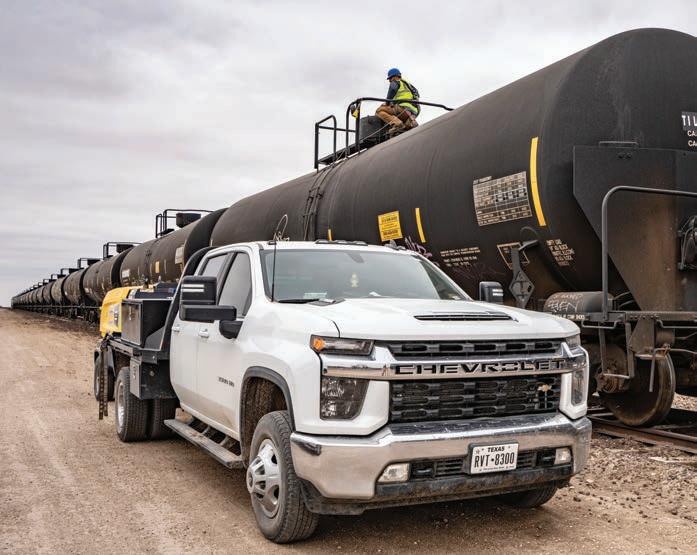
Tank cars play a crucial role in the supply chain. They are indispensable to modern logistics, enabling the safe and efficient transportation of a wide range of commodities. Today, TrinityRail is an industry-leading supplier of tank cars with a focus on design, manufacturing, maintenance, and other value-added services.
Our engineers focus on tank car designs that leverage a need for rigorous regulatory compliance, evolving product specifications, and innovative features to deliver a robust, high-quality car to move products safely and efficiently. Given the regulatory environment, we are active in industry and federal rule making bodies and apply focused, quality assurance processes throughout our tank car operations.
Innovation can be seen in the introduction of features such as a robust, service-proven draft sill, a highly configurable operating platform based on commodity and customer specific needs, coil systems to promote greater operational efficiencies, and new, ergonomic
safety appliances.
The manufacturing environment has changed significantly. In the 1980s, the railcar manufacturing industry went through a prolonged downturn with extensive consolidation and contraction. Our company, with a long-term history of operational flexibility and dedication, not only survived but prospered. By the end of the decade, demand had slowly returned and we had built industry-leading tank car manufacturing resources along with the beginnings of a service-focused view of the market. Since 1990 alone, we have produced over 220,000 tank cars, establishing TrinityRail as a leader in the tank car manufacturing space touching customers and building relationships throughout multiple tank car markets including the chemical, agriculture, and food products sectors.
The growth of the tank car market has also driven a need for repair and maintenance services to help tank car owners maximize fleet utilization and remain in compliance with industry regulations. TrinityRail combines full-service maintenance shops with growing on-site and fast-track operations along with a growing network of mobile repair units to provide greater touchpoints and capabilities for
our customers’ tank car maintenance needs. We have also seen the expansion of automated technologies to enhance quality control and employee safety. Earlier in 2025, as part of the American Chemistry Council’s Responsible Care® Awards Program, we were proud to be presented with a Product Safety Award for the Tersus Robotic Tank Car Cleaning System.
TrinityRail identified the challenge of minimizing confined space entry in hazardous tank car cleaning operations. To address the issue, the Tersus system was implemented which effectively removes residual commodities from tank cars without requiring personnel to enter confined spaces. This enhances workplace safety while efficiently cleaning and preparing tank cars to return to service.
Leasing with TrinityRail provides access to one of the largest fleets in North America with over 140,000 owned and managed railcars. In addition to leasing’s financial benefits, you can better manage your fleet by being more responsive to changing business conditions, commodity requirements, and the regulatory environment. You also gain access to TrinityRail’s comprehensive line of pressure and non-pressure tank cars and extensive in-house engineering and fleet management expertise. A growing supply of tank car parts are available as well as on-site operational assistance and training.
Tank cars are continuously moving products across North America including hazardous commodities. To help ensure these products are moved safely and responsibly, solutions are being developed to help drive greater insight and clarity into tank car logistics. For more than forty years, rail shippers have been increasingly relying on software and services from RSI Logistics to make their rail shipping simpler, more efficient, more insightful, and more cost-effective. Rail solutions from RSI include railcar tracking and management software, rail rate analysis software, rail logistics services, rail terminal services, rail data and insights, and yard management. Access to real-time, actionable data to optimize and visualize your supply chain and better manage your tank car fleet has never been greater. Learn more about our tank car products and services at www.trinityrail.com.

Tank car maintenance and support from TrinityRail Mobile Repair

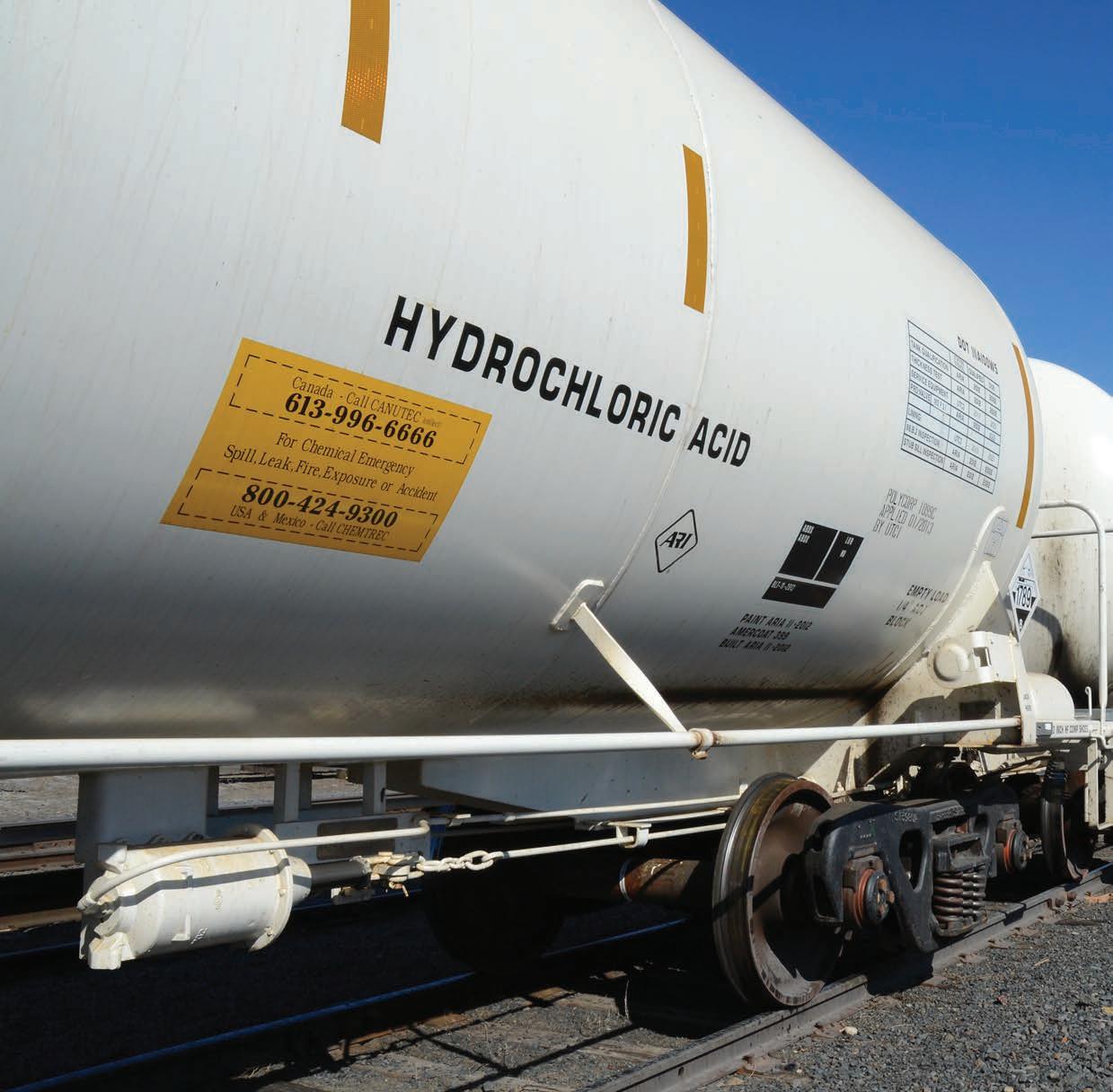
STABLE MARKET— FOR NOW
North America’s tank car fleet is relatively young. Regulations, though tricky and challenging,
should benefit carbuilders, component suppliers and lessors.
BY WILLIAM C. VANTUONO, EDITOR-IN-CHIEF
Tank cars, the second-largest railcar group in the North American fleet after covered hoppers, represent the most diverse commodity base in
railroading. They are their own ecosystem, with a whopping 854 STCC (Standard Transportation Commodity Code) designations. Chemicals and Refined Products represent the largest subgrouping of the
commodity groups, each with more than a half-million loads annually.
Tank car designs have mostly stabilized after the post Lac-Mégantic period of evolution and redesign. The replacement
Bruce Kelly

rate is approximately 8,000 cars annually, excluding regulatory requirements to phase out older, hazmat-carrying cars. In 2024, approximately 10,000 new units were built.
Regulatory issues remain on the table, among them HM-246, governing veryhigh hazard-commodities, mostly TIH (Toxic Inhalation) commodities such as chlorine, anhydrous ammonia and ethylene oxide. More regulatory changes fall under the FAST Act, such as HM-251, governing hazardous flammable liquids
TANK CAR SPECIAL REPORT
like crude oil and ethanol. There is potential for regulation acceleration in the wake of East Palestine.
Tank car regulations are tricky and challenging, but should benefit carbuilders, component suppliers and lessors. The U.S. and Canadian governments enacted legislation updating the phaseout date of all tank cars used for transport of flammable liquids, except DOT-117J (new) and DOT-117R (rebuilt) cars, to May 1, 2029. The phaseout is applicable to loaded and residue shipments.
According to U.S. DOT Hazardous Materials Regulations, all jacketed and unjacketed legacy Class 111s, as well as jacketed and unjacketed enhanced Class 111s (also called CPC-1232s), will be prohibited from importing, offering for transport, handling or transporting unrefined petroleum products, ethanol, and Class 3 flammable liquids in Packing Group I. Under Transport Canada’s Containers for Transport of Dangerous Goods by Rail standard, the same restrictions apply for Packing Groups I, II and III.
New legislation affecting tank cars is the OBBBA (One Big Beautiful Bill Act), which significantly impacts the Section 45Z Clean Fuel Production Credit, extending the credit period, modifying feedstock requirements and clarifying rules related to Foreign Entities of Concern (FEOCs). Specifically, the OBBBA extends the sale deadline for eligible fuel under Section 45Z to Dec. 31, 2029. It also introduces stricter domestic feedstock requirements for fuel produced after Dec. 31, 2025, limiting eligible feedstock to that produced or grown in the U.S., Mexico or Canada. Additionally, the OBBBA introduces restrictions on FEOCs claiming the credit, with specific rules for entities related to or conducting significant transactions with FEOCs, impacting various clean energy credits including 45Z.
For this report, Railway Age asked tank car market stakeholders for their longterm view on the tank car market. What types will be in demand and why? What is the regulatory outlook? The equipment finance perspective?
“The rental market for tank railcars is the most service oriented of any operating lessor dominated railcar leasing market,”
says Railroad Financial Corp. President and Railway Age Financial Editor David Nahass. “That’s not exactly news—it has been that way for some time. However, as the cost of maintaining a tank car continues to rise, that dynamic continues to favor lessors who can provide the necessary levels of service to their customers.
“What specifically has changed? The regulatory process and record-keeping requirements provide lessors an opportunity to flex their financial muscle and expertise to the benefit of their customers. Specifically, the ten-year required recertification process for all tank railcars, HM-216, is costly, and shop availability can be sporadic. Railcar end users need to maintain technical and operational expertise to handle the process in a timely, efficient and cost-effective manner. Having a lessor partner to help with the process is a draw for end users.
“Overall, the rental market for tank cars continues to remain relatively robust even as the market has seen some limited pockets of weakness. There is anecdotal evidence that rates have retreated from loftier highs of late 2024, but there is fundamental strength underpinning the market that is unlikely to dissipate in the near future. There are a few core reasons for this:
1. “Tank railcar supply is running below at the rate of replacement.
2. “The replacement cycle for cars included in HHFT (high hazard flammable trains) is not yet completed.
3. “Growth in the chemicals loadings segment (chemicals, along with petroleum and petroleum products are the largest commodity groups for tank railcar use).
4. “Even with modest annual production of new tank railcars, tank railcar prices remain elevated vs. prepandemic prices.
“The industry has handled the HM-216 bubble well—better than many people expected. Tank railcar supply remains consistent, so expectations for a downturn in rates should be tempered. The costs of tank railcar maintenance seem to be rising more rapidly than the cost of new cars; that would suggest continued opportunities for lessors to provide high-level service to customers and to maintain strong leasing

margins into the near future.”
At Railway Age’s Rail Insights 2025 conference, Nahass spoke with Katherine Suprenuk, President of Leasing and Manu facturing, Union Tank Car Company & Procor (a Marmon/Berkshire Hathaway Company), about the tank car market. “We’ve talked about circumstances that might change the demand cycle and potentially be drivers for increased build ing of new cars,” Nahass said. “Addition ally, we see fleet attrition in many classes of assets due to the aging of cars. Can you imagine a time where, because of having had low backlogs for some time, we



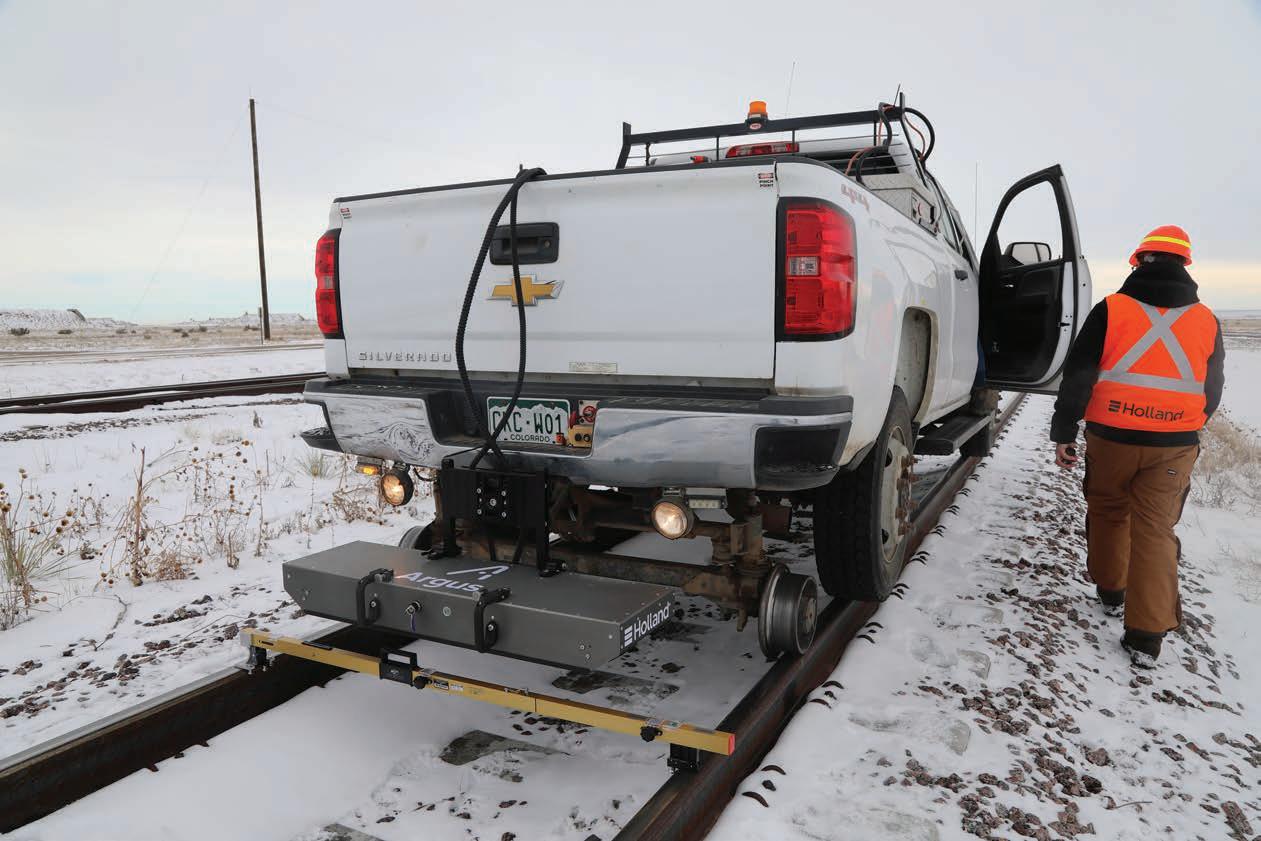
observed. “Even with the tariffs and other economic related uncertainty, the economy seems like it’s poised for a downturn. We’re not sure, but are we seeing it to some degree in the plastics market as an example? Do you see continued strength through the remainder of the year in the chemicals segment, or will we see economic weakness cause a little bit of a pullback?
“Chemicals are very relevant for tank cars,” Suprenuk said. “Half of tank car loaded moves comes from chemicals. We do watch that closely, and you’re right, that has been a relative bright spot in the loadings profile for things moving in tank cars. But the year-over-year growth we’re seeing is about one percentage point year to date, which is more modest. Generally, I believe it should be positive in 2025, but the growth may wane to some extent. Looking at the broader economic context, there’s other indicators that are showing signs of contraction in manufacturing. The PMI (Purchasing Managers Index) has been signaling a slowdown for the past several months. GDP (Gross Domestic Product) and IP (Industrial Production) forecasts show modest year-over-year growth. All this points to continued fragility in overall demand, which if it continues could soften chemicals to some degree. But I still think for the year, it’ll probably be up vs. last year.”
“Are there notable regulatory initiatives under way that could shape the tank car market and have an impact on all the things we’ve been discussing?” Nahass asked.
“There’s one area that could have a significant impact on the industry in a positive way: HM-265, which addresses hazardous materials regulations. Last year, PHMSA (Pipeline and Hazardous Materials Safety Administration) put forth a notice of proposed rulemaking (NPRM) that proposes revising the hazardous materials regulations. Union Tank Car, through the RSI (Railway Supply Institute), submitted input through the normal comment process as we usually do, and that will help shape the regulations, aiming overall to increase efficiency while maintaining safety standards that we have. With this evolving NPRM, there are a couple of areas related to deregulation of authority that RSI would like to see included in a final rule. One relates to quality assurance programs for tank car repair shops. The other has to do with tank car design approvals.”
“As for existing quality assurance programs, the AAR owns and enforces them. The proposal is that we allow tank car facilities to adopt any established quality assurance program and still be subject to audits against that program, giving them more flexibility. This would align the AAR with what is already in place at Transport Canada. As for tank car designs, currently they require approval by the AAR Tank Car Committee. On the table is making it acceptable to use ‘design-certified engineers’ instead of the existing AAR approval process. Both these changes, if implemented, would promote efficiency and innovation. The tank car supply industry is quite supportive. We view these changes to be in alignment with the objectives of the current Administration, and we hope that PHMSA continues to make HM-265 a priority and push it forward.”
“The tank car fleet is young, so replacement will play less of a role in tank deliveries than regulatory and commodity growth drivers,” says TrinityRail Chief Commercial Officer Charley Moore. “Deliveries for HM-251 and HM-246 compliance are
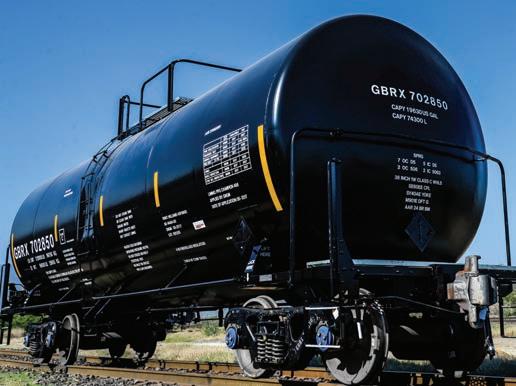
“We view the long-term tank car outlook as stable, led by replacements.” – The Greenbrier Companies, Inc. Vice President of Marketing and General Manager Tom Jackson.
ongoing, and tank cars move key commodities integral for North American Energy Transition, like soybean oil, renewable diesel and acids. Regulatory requirements have been a big driver in new and existing tank car demand over the past several years. Shippers continue to make progress in complying with HM-251 and HM-246. In addition, qualification requirements for existing tank cars are a big driver of elevated maintenance events and costs for shippers and lessors. As well, we have seen strong interest for telemetry within the tank car fleet. Given the sensitive
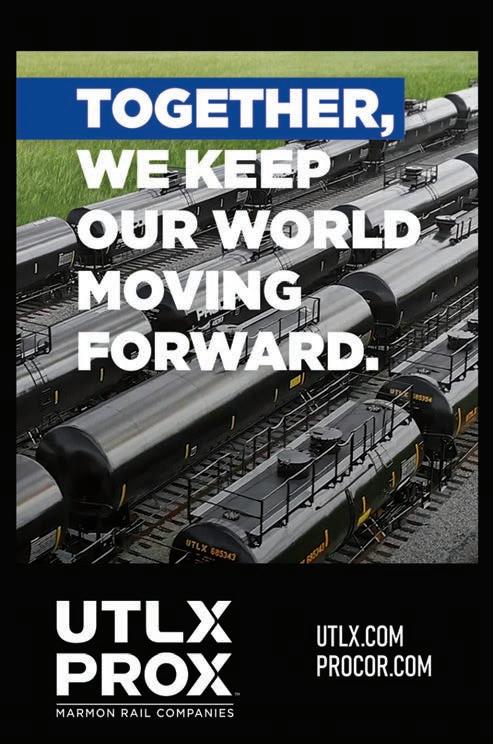

nature of some of the commodities moved in tank cars, increased visibility to location, temperature, etc., can give tank car shippers a competitive edge.”
“We view the long-term tank car outlook as stable, led by replacements, with some modest growth at roughly 10,000 units annually for the next five years,” says The Greenbrier Companies, Inc. Vice President of Marketing and General Manager






Tom Jackson. “One of the key areas driving this growth is renewable feedstock, particularly from seed oils such as soybeans. Our confidence in this outlook was further bolstered by the recent passage of the 45Z tax credit within the OBBBA on July 4. While we do not foresee major growth catalysts like those experienced during the Ethanol Boom or the Crude-by-Rail eras, this stability is beneficial from a builder’s planning perspective, as it allows us to avoid significant production ramp-ups and ramp-downs.
“Additionally, we are expecting modest growth in the Pressure tank car segment. Of the 450,000 tank cars in service, General Purpose (GP) tanks make up 80% of the total, while Pressure tanks comprise the remaining 20%. Interestingly, we expect the Pressure segment to outpace the growth of GP tanks over the next five years. This anticipated growth is largely driven by the regulatory phase-out deadline of May 1, 2029, for other flammable liquids in Packing Groups II and III.”
“The tank car fleet is young, so replacement will play less of a role in tank deliveries than regulatory and commodity growth drivers.” – TrinityRail Chief Commercial Officer Charley Moore.


FREIGHT RAIL
AI EVOLUTION
Artificial Intelligence is a controversial subject—though not for railroads when it comes to safety, if used properly.
BY JOANNA MARSH, CONTRIBUTING EDITOR
The North American freight rail industry needs multiple technologies informed by artificial intelligence and machine learning to counter and address the complex needs of the vast North American rail network, sources told Railway Age. The railroads are responsible for monitoring 1.6 million railcars and more than 26,000 locomotives traveling on 140,000 of railway track located in diverse terrain, and AI-informed technologies ranging
from ultrasounds and electromagnetics, to drone-based inspection systems, optical-based systems and LIDAR, help to do just that.
“When we talk about the railroads— and this is true for applications in other fields, like in aerospace or pipeline or any industry—not everything can be inspected, mainly because there is a lot of variability in the equipment part,” said Anish Poudel, a Principal Investigator II with MxV Rail’s nondestructive evaluation team. Poudel is involved in testing
AI-informed technologies at MxV Rail. And that’s why “we rely on multiple technologies to kind of overcome the limitations of one technology versus another. So there is always a benefit of using multiple technologies that will allow you to see things differently,” he said.
AI’S EVOLUTION IN FREIGHT RAIL
The use of AI and machine learning in the freight rail industry has been well under way for quite some time. For instance, among the Class I
ADVANCED TECHNOLOGY
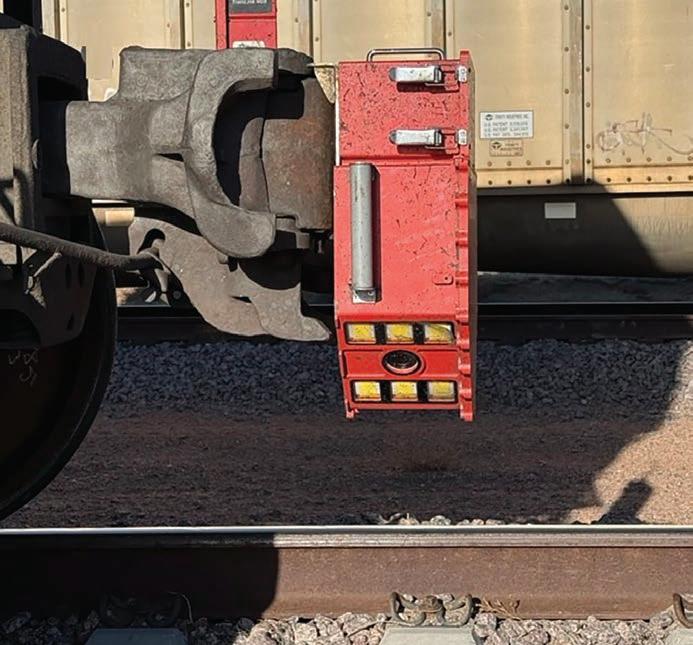
MvV Rail’s LTTS TrackEi™ Optical broken rail detection system, currently under evaluation at FAST under the AAR SRI rail inspection technology program. It uses Machine Vision technology on an edge computing device coupled with deep neural network architecture to intelligently capture visual defects using cameras and characterize it using AI/ML algorithms.
railroads, western carrier BNSF uses AI in conducting wheel inspections, tracking container inventory at intermodal yards and making switching operations more efficient. Union Pacific has developed a ChatGPT-like tool that can analyze data trends.
Indeed, while AI has become a buzzword in the past several years, the concept has existed in the freight rail industry for decades, according to Poudel. In the 1970s and 1980s, the rail industry, along with other industries, utilized a low-level AI application known as the “perceptron technique” to develop an artificial neural network. However, the model ultimately failed because people were “under the notion that AI would solve everything— you build one model, and then you apply a wide range of applications,” Poudel said. “It was kind of like a one-size-fitsall kind of thing. And it failed.”
Despite the failure, people continued to build algorithms for AI, including those for machine learning, a subset of AI where a computer is taught to learn patterns. The advent of the deep learning neural network in the early 2000s opened endless opportunities for AI,
including what people know today as large-language models, according to Poudel. “The railroads have been using some level of pattern recognition algorithm tools for many, many years. These were very low-level machine learning algorithms. But now, I would say that yes, the railroads do use advanced analytics,” such as deep learning models to process images from inspection portals that take pictures of speeding railcars, Poudel said. Such train inspection portals are in use at eastern Class I’s CSX and Norfolk Southern.
These inspection portals are comprised of multi-camera systems and lighting systems that can take millions and millions of images of railcars going at track speed, according to Poudel. These images are fed into the deep learning models and enable the railroads to get real-time information on the health of the railcar, he said. The benefit of using this kind of technology is that it can enhance mechanical inspections, which can otherwise take an hour to inspect both sides of a 120-car train. The images can also be taken in the middle of the night, or if it’s raining or snowing.
Algorithms can also be developed to focus on searching for specific defects, such as broken wheels or defects on railcar springs. “You have an opportunity to do that inspection 24 hours a day, seven days a week, 365 days a year. So, in terms of productivity, I think using the machine vision systems, especially for looking into the rolling stock component, is a shift change,” Poudel said.
Indeed, one of the challenges in using AI now is the velocity and veracity at which data is coming out, according to Poudel. “This data is growing much, much faster than ever before,” and the data is imposing a lot of processing demands as a result, Poudel said.
One goal involving big data is whether it can be used to create real-time inspections, Poudel continued. Because so much data is being produced, “you have to rely on a machine to be able to assist you in terms of pinpointing where the problems are,” he said. This is why the human is still an important factor, because “you cannot just let the system go alone. You need to have the human in the loop there,” he said. “There is a notion that, in different communities, the machine is going to take my job away, or something like that. It’s never going to happen. People are an important part of the equation.”
Poudel’s view of the human’s key role is also shared by Mika Majapuro, Vice President of Commercial Product management for Railinc. “Personally, I’m a big believer in humans and AI. It’s hard for me to see that AI would replace a ton of people in our field. You’re still going to need people who can look at the data and make critical decisions,” Majapuro said. “However, AI might support new employees in the freight rail industry by providing them with knowledge akin to that of an industry veteran. The big thing is, how can I make my new people perform like someone who’s been doing this for 20 years? And I think that’s where you’re going to see advances. And then, when there’s too much information, too much chaos, the tool can make some recommendations for you. It’s still up to the user to make critical decisions: What am I going to do with this prediction or with this recommendation?”
MxV Rail
ADVANCED TECHNOLOGY
AI AND MACHINE LEARNING PRACTICAL APPLICATIONS
As Poudel mentioned, the freight rail industry has been using AI and machine learning for years. The products that are available now build more sophistication upon existing offerings.
Railinc has been working since 2018 on developing AI to improve the estimated time of arrival, according to Majapuro. Since Railinc’s initial offering of Advanced ETA, Railinc has produced at least three new updated editions. “We like to say that when we talk to shippers and ask them, what are your three top pain points? They say, ETA, ETA and ETA,” Majapuro said.
Railinc’s AI-informed product to improve ETA involves working with data provided by different railroad companies. For instance, NS may need to hand over a railcar to CSX, and Railinc functions as the middleman, where different data is passed between different parties with permission to view that data.
The product functions as a neural network model that looks at factors such as location, car type, commodity, time of year and time of the date to predict an estimated time of arrival. The data that feeds into Railinc’s ETA offering comes from wayside detectors along track in the U.S., Canada and Mexico. “As the car travels, we continue to make updates on the prediction,” Majapuro said. “Railinc’s ETA offering also uses historical weather patterns as an inpute, further enabling more informed decision-making.” For the freight rail industry, “sometimes it’s measured in weeks how long it takes to go from origin and destination, and you have crews that are timing out and trees falling on tracks. That’s why the ETA challenge has been so difficult for many companies to solve. There are so many variables. That’s why we’re so proud of the work that we’re doing, and being able to help the industry and help the shippers.”
Another Railinc offering that uses data from the wayside detectors is one that monitors the wheelset health. This offering also uses neural networks, which “is obviously a different model than what we use for the ETA, but with some of the same principles,” Majapuro
said. “You want to be able to replace those wheel sets before something bad happens. But also, there’s a convenience factor. If you can make predictions when the wheel set will fail, you can control when and how you’re going to change the wheelset.”
The wayside detectors have a reader that measures the force that the wheel is applying against the track, Majapuro continued. “We take that data, and then we take the time of the year, for example, and the miles on the current wheels, and we can make predictions on the likelihood that an alert will be triggered to replace the wheels.” The offering can also gauge the severity level of the alert, he said, allowing the railcar owner to maintain the car and replace the wheels when it’s convenient.
This type of insight is also valuable as a lot of very experienced railroaders are retiring, leaving behind a newer, incoming workforce that may lack institutional knowledge to make informed decisions. “You can use AI to make sense of that and prioritize tasks for you—maybe not trusting the AI to make the decisions, but the AI can propose to you, hey, it’s eight o’clock on Friday, these are the five things that you should be working on.”
Meanwhile, at MxV Rail, Poudel is involved in testing the application of machine learning on rail inspection that uses ultrasonic technology. The ultrasonic technology detects flaws at the microscopic level, and the machine learning will seek to characterize the flaws. Currently, the railroads collect data that eventually makes its way into the back office via an internet connection or some kind of communication architecture. The data gets processed using cloud architecture, and then the results get transferred to the maintenance group.
But what Poudel and other researchers want to know is if machine learning can enable the railroads to make decisions on the fly, or as the data is being collected. “What we’re trying to do is, can we implement machine learning or AI in the same device where you collect the data and make that decision in real time,” Poudel said. “That would definitely improve the efficiency in terms of, you don’t need to
go back to the track again and occupy the track and reverify it. If we can do that on the fly, that would be a huge step change.”
Poudel and MxV Rail researchers are also looking at applying machine learning using an edge computing device as well as saving raw data, which could open up the possibility of data fusion,” Poudel said. “The goal is the same towards the end: to prevent the rail failure,” he said. “So, our goal and our vision is, can we come up with a methodology that would allow us to communicate with other forms of data stream and blend this data together, fuse this data, to come up with the high-level findings, and find or predict this discontinuities or anything that can go wrong with the rail ahead of the time.”
COLLABORATION IS KEY
Just as multiple AI-informed offerings and products are needed to respond to the diverse safety and operational challenges facing the freight railroads, so are multiple stakeholders needed to ensure that AI and machine learning are utilized effectively. “Input from these stakeholders may come from technical committees affiliated with the Association of American Railroads, or they may come from researchers’ white papers. Companies can take the findings from the resources and see how they apply to existing models and products, Majapuro said. “There are a lot of technical committees and meetings where our best practices are shared.”
Poudel agrees. In the committees involving the railroads, original equipment manufacturers and technology suppliers, “there is a great collaboration,” he said. “They don’t share exactly what they’re doing, but in general, they share experiences with each other that would allow them to work together and bring the technology forward. When you collaborate with different people, that’s where the innovation comes. So, when it comes down to AI, I think we as an industry need to figure out a way in terms of how we can share data and collaborate with others, because to be able to train a good model, you need tons and tons of data, and that’s only possible through collaboration.”







W OMEN IN RAIL AILWAY GE









October 15 & 16, 2025
Hyatt Regency Schaumburg Schaumburg, IL



Connect. Inspire. Innovate.


Women in Rail 2025 is a must-attend event, highlighting diverse experiences and practical strategies for moving the industry forward.

The third annual conference features dynamic panels, a celebratory awards luncheon, and the chance to network with a wide-reaching group of like-minded rail professionals.
Join Us For:




• Leadership Journeys in Short Line, Transit, Freight & Engineering






• Railroading Heroes
• Commanding the Track: Your Leadership Toolkit


• Executive Edge: Branding, Negotiation & Presence



Supporting Organizations






• Trackside Impact: Environment & the Community


• Allyship to Action: Maintaining a Culture of Belonging


• Railway Age Women in Rail Awards

• RT&S Women in Railroad Engineering Awards















































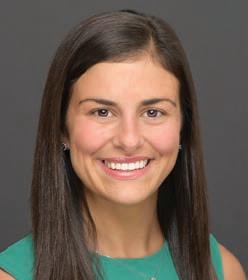












































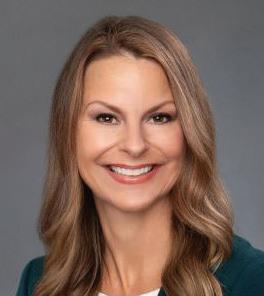




BRIGHTLINE
Something Different on the Rails
BY DAVID PETER ALAN, CONTRIBUTING EDITOR
For 115 years after Railway Age began publishing in 1856, passenger trains were operated by private-sector railroads. That changed in 1971, when Amtrak was formed to keep a small number of trains going, while most were discontinued, a change that represented financial relief for hard-pressed
railroads. During the 1970s and ’80s, the railroads were able to turn their local passenger operations over to public-sector transit authorities, who kept them going, mostly in the nation’s largest cities.
Today, there is talk of private-sector passenger trains once again. Two potential operators want to run overnight businessoriented trains, including luxury features.
RAILnet-21 proposes an investor-owned Infrastructure Management Organization (IMO) that would manage Amtrak’s mileage on the Northeast Corridor (NEC) and elsewhere, while AmeriStarRail (ASR) has proposed operating more trains on the NEC and its branches than Amtrak runs today, and with some additional routes. We recently reported on ASR’s plan for
Brightline
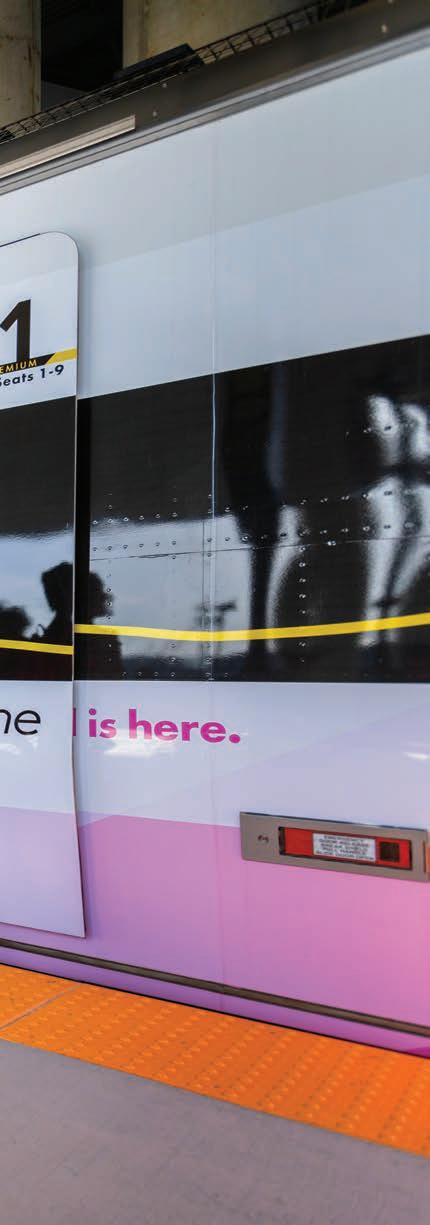
the Transcontinental Chief, which would run between New York and Washington, D.C., in the East and Los Angeles in the West, including on the historic Santa Fe route where Amtrak’s Southwest Chief runs today. Still, these are all proposals, rather than trains actually running.
IT STARTED IN FLORIDA
There is one significant private-sector passenger operation in the United States today. It’s Brightline, which runs between Miami and the Orlando
airport, with intermediate stops that include Fort Lauderdale and West Palm Beach. It began as All Aboard Florida (AAF) in 2012, became Brightline in 2015, and began operating on the southern part of the Florida East Coast Railroad (FEC) in 2018. For more than five years, Brightline operated a unique three-stop service between downtown Miami and West Palm Beach, with its only intermediate stop in downtown Fort Lauderdale. It was new-looking, novel, and faster than the more-traditional local service offered on Tri-Rail, mostly located several miles inland.
On Sept. 22, 2023, Brightline began serving Orlando International Airport (MCO), a northward extension that had been in the works for years. The journey from AAF to MCO has not been a smooth one, but it has attracted a lot of attention, including reports in the local Florida papers and other media, national news outlets, and publications such as Railway Age. Brightline’s path toward Orlando has had more twists and turns than the actual railroad.
AAF was started in 2012 by Florida East Coast Industries, a real estate arm of Fortress Investment Group. In that sense, the railroad’s founders emulated the FEC’s founder, real estate developer Henry M. Flagler, who was active during the late 19th and early 20th centuries.
Construction started in 2014 and the first service, between Fort Lauderdale and West Palm Beach, began in 2018. It was extended to downtown Miami later that year, to a station that now also hosts Tri-Rail’s “Miami Link,” but with separate entrances for each service. They run on separate railroads and serve different customer bases, and Miami Central Station is their only point in common.
I have reported relatively often on Brightline since I came on board at Railway Age in 2018. The first major story I covered was Brightline’s flirtation with Richard Branson’s Virgin brand. The Brightline brand disappeared briefly, and Branson’s Virgin Group hailed the “Red Spike Era” for “Virgin Trains USA,” but Brightline and Branson had a falling-out and the Brightline brand came back.
The original FEC service ran between Miami and Jacksonville and served as the
PASSENGER RAIL FOCUS
Florida segment of through-routed trains to and from places like New York and Chicago. The trains served such tourist meccas as St. Augustine and Daytona Beach, as well as the areas now known as the Space Coast and the Treasure Coast. That operation ended when a multi-year strike began in 1963, and the last remnant of the old service ended in 1968. Communities like Stuart, Fort Pierce, Vero Beach, and Cocoa lost their trains and have not hosted a passenger train since. The affected counties, especially Indian River County (where Vero Beach is), sued Brightline over financial and safety issues, although some residents were aggrieved because they would not have the benefit of any trains stopping in their towns. Infill stations at Aventura and Boca Raton, on the part of the line where service began in 2018, opened in December 2022. There are also plans to build new infill stations at Stuart and Cocoa, which are north of West Palm Beach, with service expected to start in 2028.
The next big news came on Sept. 22, 2023, when trains ran to the Orlando airport for the first time. The FEC route from West Palm Beach to Cocoa was upgraded, and Brightline built new railroad along the Beachline Expressway between Cocoa and the airport, track rated for 125 mph. It’s not “high-speed rail” by international standards, but we call it “higher-speed” or “high-performance” rail.
The trip takes 3:25 or 3:30 between Miami and the Orlando airport, and trains run roughly hourly for most of the service day. Trainsets previously consisted of four cars: one Premium Class car with 2-1 seating, and three Smart Class (Brightline’s name for a conventional coach) with 2-2 seating. There is now an additional coach or two, with a 4,000-hp Siemens Charger SCB-40 unit at each end. Brightline has ten such sets and ordered 30 more cars to lengthen them. Some of those cars are already in service.
HSR UNDER CONSTRUCTION AT BRIGHTLINE WEST
Meanwhile, as Brightline was developing its service in Florida, efforts were under way to serve Las Vegas with passenger trains for the first time since 1997. The initiative began as DesertXpress in 2005
PASSENGER RAIL FOCUS

and later became XpressWest. The original plan was to run between Las Vegas and a point in the Victor Valley in Southern California. The nearest town of any size is Victorville, a stop on Amtrak’s Southwest Chief located about three hours’ running time east of Los Angeles. Fortress Investment Group acquired XpressWest in 2018 and rebranded the project as Brightline West in 2020.
Construction started in 2024, and most of the line will be built in the median of highway I-15. Plans call for
a “Victor Valley” station in the town of Apple Valley and one at Hesperia, also in the Mojave Desert region. The line will be single track with passing sidings, which will require precise scheduling and operation, especially since the top speed is slated to be 200 mph (FRA Class 9), which meets the standard for true high-speed rail. Siemens will supply ten seven-car trainsets, and the line will be electrically operated. Current plans call for service to begin late in 2028, running 45-minute headways.
Current plans also call for an extension to a “Southern California Station” (as Brightline West calls it) at Rancho Cucamonga, which is currently served by the San Bernardino Line on Metrolink, which runs regional trains, mostly to and from Los Angeles. Brightline West says that the station “will be co-located with existing multi-modal transportation options, including Metrolink, for seamless connectivity to Downtown Los Angeles and other destinations through Los Angeles, Orange, San Bernardino
Brightline West
and Riverside Counties.” That’s where Metrolink goes.
The current Metrolink schedule would not provide connections for all Brightline West trains, but it will allow access to the Los Angeles catchment area, with its millions of people. With the recent expansion of rail transit in and near the city, Los Angeles has become a place where it is possible to live without an automobile, and some Angelinos are doing that. They are slated to have access to Las Vegas through Brightline West, even though it would be a two-seat ride, with a transfer at Rancho Cucamonga. There is also a proposal to build a second route that would allow access to the Los Angeles area: the High Desert Corridor. It would run from the Victor Valley Station at a point near Victorville, west to Palmdale on Metrolink’s Antelope Valley Line, which terminates further north at Lancaster. It would connect with Metrolink (schedule permitting) for a two-seat ride to or from the city. Palmdale is also a proposed stop on the again-embattled California High-Speed Rail (CAHSR), line if it is completed.
According to Brightline West spokesperson Antonio Castelan, the Las Vegas station would be “right on Las Vegas Boulevard near Warm Springs Road, next to the I-15. This is about ten minutes south of the Strip. The train station will be set up as a mobility hub. Passengers will be able to connect with rideshare services, buses and regional transit. We are making our passengers’ travel as convenient as possible.”
BRIGHTLINE WEST BUILDING; FLORIDA FACES CHALLENGES
Castelan told Railway Age construction is moving forward: “Brightline West has completed approximately 99% of its field investigations, including geotechnical borings, utility potholing and environmental surveys along the I-15 corridor. Initial construction activities are under way in both California and Nevada, with the first heavy civil work expected to ramp up in late 2025. The route will span approximately 218 miles, with trains operating predominantly within the I-15 median.” He projected a travel time for that distance of two hours
and ten minutes, which would place the average speed at slightly more than 100 mph, within the range of what we call “high-performance” rail. Some segments will allow faster speeds, specifically the part along the median of I-15. According to Castalan, “The corridor supports maximum line speeds of 200 m ph, with everyday operational caps near 186 m ph, except where gradients or terrain necessitate lower speeds.”
On the Florida side, the big news came almost two years ago, when service began on the extension to the Orlando airport. Efforts are continuing to secure financing through bonds for capital construction on the Sunshine Corridor in the Orlando area, which Brightline and local operation SunRail plan to share, and a further extension to Tampa. WFLA in Tampa reported on July 18 that the proposed extension to that city is gaining community support.
Miami NPR station WLRN reported on July 16 that Brightline’s ridership had dropped, and so had its bond rating. Trains were lengthened recently to increase capacity, and departures that were cut from the schedule were restored in June. However, Chris Persaud reported in the Palm Beach Post on July 18: “For the first time in about two years, the private passenger train Brightline is gaining riders following its reintroduction of commuter passes for the tri-county area, but ridership in the region still lags far behind 2023 figures. Brightline lost about $549 million in 2024, in large part due to paying $218 million to refinance its debt of about $4.6 billion.”
ADVOCATE’S VIEW
James Tilley, President of the Florida Coalition of Railroad Passengers (FRCP), has been a Railway Age contributor. This is his assessment of Brightline and its future: “Brightline has been a godsend. I no longer drive all the way to south Florida from Jacksonville but will drop the car in Orlando and take the train from there. Reasonably fast—especially between Orlando and Cocoa prior to operating over FEC. But, more important, it’s incredibly reliable even with shared freight trackage.” Regarding the financial side, he told Railway Age : “It
PASSENGER RAIL FOCUS
is difficult to envision Brightline’s existence absent common ownership of both FEC and Brightline by Fortress. In its previous role as FEC’s owner, Fortress was able to press forward with a major passenger project. However, as a standalone business, it is difficult to envision the future. The railroad is highly leveraged, and its debt service is heavy. Operating losses remain significant despite the growth of revenue and passenger count. While Brightline returns to the bond market for funds to build out the Tampa extension, the ratings agencies have expressed concerns regarding the increasing load of debt Brightline now carries, which will increase.”
THE FUTURE
Both Brightline entities have ambitious plans, especially Brightline West, which would become the first true HSR line in the U.S. if things go as planned. Expansion plans for Brightline in Florida are more modest, with the next potential extension being the proposed Sunshine Corridor running west from the Orlando airport, which Brightline and local predominantly regional/commuter railroad SunRail would share. While still years off, the Sunshine Corridor would help Brightline reach Tampa.
There has also been talk of extending some Brightline service north on the historic FEC main, all the way to Jacksonville. The FEC served the popular destinations that were developed by Henry M. Flagler, and it was faster than the route Amtrak currently uses.
If Brightline ever runs as far north as Jacksonville and figures out how to connect with trains from points north, rail travel to Florida will have come full circle and returned to its original popular route. It will be a case of either “Forward, into the Past” or “Back to the Future” of rail travel in the Sunshine State. In the meantime, the railroad’s management hopes that much sooner, Brightline West could be running genuine HSR on at least a part of the route between Los Angeles and Las Vegas—even it requires a two-seat ride to go all the way, at least until Brightline West can run directly into Los Angeles Union Station.

DERAILMENT
BY GREGORY HOLTMAN, TRAINING COORDINATOR; AND MATTHEW DICK, P.E., VICE PRESIDENT STRATEGY & BUSINESS DEVELOPMENT, ENSCO, INC.
Preventing derailments is critical to rail transportation to enable its safe and efficient operation. In the worst-case scenario, a derailment can lead to casualties and property damage. But even in the best-case scenario they lead to network delays that increase costs for the economy. Looking over the last several decades, North American freight rail transportation has made tremendous improvements decreasing derailments. There was a significant reduction in derailments from 2004 to 2024 according to the Federal Railroad Administration (FRA) derailment statistics. This reduction can be attributed to many factors including the widespread deployment of track and rolling stock automated inspection technology. However, from 2014 to today the total number of derailments has been flat. Track caused derailments have continued to decrease since 2014, but Human Factors and Miscellaneous caused derailments have increased.
One of the best methods to further decrease derailments is the investigation process. Conducting an accurate and scientific investigation is paramount to understanding the root cause (or combination of
causes) to properly identify and implement an effective prevention strategy.
INVESTIGATION FUNDAMENTALS
From July 22-24, 2025, the Transportation Technology Center in Pueblo, Colo., hosted a workshop with more than eighteen freight and passenger railways to learn, collaborate, and discuss the art and science of derailment investigation and prevention. Some of the skills that were taught are from the first steps of arriving at the site of the derailment, including sketching basics, finding the Point of Derailment (POD), reviewing the Locomotive Event Recorder and several other aspects of the investigation process. Most importantly, the workshop included handson activities with track and both freight and passenger rolling stock. Unique TTC hands-on activities included creating a site sketch of derailment pile of cars, performing track measurements at and around the POD, and performing a first derailed car truck inspection.
At a high level, there are three main types of derailments: 1) a human factor that affected operations such as an incorrectly lined switch, 2) a component that catastrophically failed
such as a broken rail and 3) a vehicle/track interaction condition resulting in a wheel permanently leaving the rail. At the workshop, each of these three types were fully explored and discussed. Catastrophic component failures can be challenging to solve. For instance, broken rail can be caused by many different factors. However, at a derailment site there can be numerous pieces of broken rail. How can you tell if the derailment was caused by a broken rail, and which piece caused it? The workshop team addressed that question along with many more.
Investigating Wheel/Rail interaction type derailments can be the most challenging of all three types to identify the primary cause, often because there are multiple contributing factors working together to cause the derailment. There are three types of vehicle/track interaction derailments. First is wheel climb where the first derailed wheel climbs up and over the rail. In this scenario there is a distinctive wheel climb mark at the POD. Second is a wheel drop where the track gauge is spread and a wheel drops within the gauge. Lastly is rail rollover where a rail rolls outward often causing the wheel flange to fall into the web of the rail. All three types can be caused by numerous
“Derailment in Place” site at the Transportation Technology Center, Pueblo, Colo.

INVESTIGATION, PREVENTION, DETECTION
different factors including track geometry, rail wear, tie and fastener conditions, ballast condition, wheel wear, truck conditions, train handling and train make-up to name a few.
An important topic the workshop discussed is how to scientifically determine what is the primary cause and what are contributing causes. Important tools to make this assessment are simulation packages to evaluate “what-if” scenarios. Examples include TEDS for track/train dynamics and VAMPIRE for vehicle/track interaction. These simulation tools are invaluable to assess what is the effect of each cause and enabling the ability to quantify how much each contributed to the end result of the derailment. The conclusion of any derailment investigation is the identification of the root cause. Next comes preventing the next derailment.
ADVANCES IN DERAILMENT PREVENTION
Derailment prevention can take many forms. These can include updating internal rules and practices, and making changes to infrastructure or rolling stock. But it can also include the adoption of safety technology. A major success story of preventing derailments has been autonomous or unmanned track geometry measurement systems. They have a major advantage in that they can operate
continuously in revenue trains without the need for a crew. This greatly increases the number of miles that can be surveyed while also dramatically decreasing survey costs. The first U.S. system was developed as an FRA R&D project started in 2008. Since then, that research facilitated the adoption and growth of the technology to be utilized by all Class I railroads and many passenger and transit systems. FRA derailment statistics show that from 2008 to 2024 there has been a reduction of 231 track geometry caused derailments, a 65% reduction.[1] Closing out the TTC Derailment Investigation and Prevention Workshop, the team discussed best practices of derailment prevention and case histories. A 2026 event is planned, and further information can be found at ttc-ensco.com/derailment-workshop.
CONCLUSION
Each year, ENSCO hosts the annual TTC Conference and Tour with this year’s event being held Oct. 7-8. The event is unique in that it brings together all stakeholders of the railway community to hear users of the TTC talk about their latest research, testing, and technology projects. Additionally, attendees get to visit the site to witness hands-on demonstrations of TTC testing capabilities and meet with suppliers that are leading with new and emerging technologies and offerings.
At the 2025 event, a hands-on demonstration with a supplier’s emerging technology will close the tour day with a freight car derailment equipped with Railway Metrics and Dynamics’s (RMD) latest Derailment Monitoring System. A single wheel or truck can derail and can be dragged for a long distance before a full derailment occurs, typically occurring at a switch or grade crossing. RMD’s system will be tested at the demonstration to detect the derailed wheel in real-time to enable slowing or stopping of the train to greatly reduce damage. More details can be found at ttc-conference.com.
REFERENCE
1. https://data.transportation.gov/ stories/s/Accident-Detail-Listing-3-18-/ vq2r-5pm7/
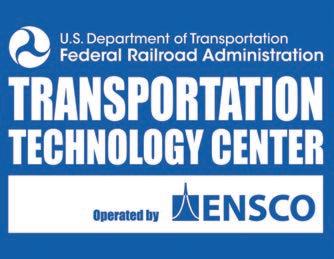
October 30 & 31, 2025
Hyatt Regency Jersey City
Jersey City, NJ
TRAIN CONTROL AND BEYOND
Next-Gen Train Control is now Next-Gen Rail Systems
Railway Age’s Next-Gen Train Control has been the industry’s single-most important communications and signaling event since 1995. For our 30th anniversary, we are expanding our program to encompass the entire system. Expert-led sessions will examine the complex integrations incorporating signaling, train control, telematics, artificial intelligence, deep data analysis, cybersecurity measures and more.
Register and connect with industry leaders, explore innovations, and stay ahead of rail project trends and regulations.





































Speakers Include

Kris Kolluri President & CEO NJ Transit

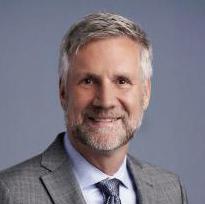
Mario Péloquin President & CEO VIA Rail Canada


Development Commission
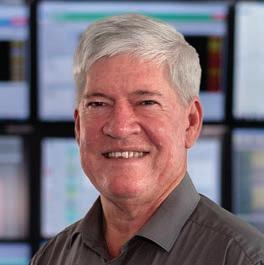

Wilson Milian, PE President & CEO Milian Consultants, LLC

Mark Salsberg Principal WDG Consulting
Supporting Organizations


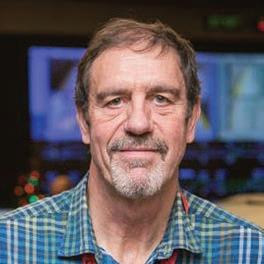


Jonathan Kirby Sr. Dir., NJT PTC NJ Transit
Robert Hanczor Founder & CEO Piper Networks
Tom Prendergast CEO Gateway
Derel Wust Company Director 4AI Systems, Inc.
Pete Tomlin Independent Consultant

JANET DRYSDALE
HIGH PROFILE: CN last month appointed Janet Drysdale as Chief Commercial Officer on an interim basis, effective immediately. Drysdale is stepping into the role following the departure of Remi G. Lalonde.
Drysdale spent the first decade of her nearly 30-year career at CN in a variety of roles in Sales and Marketing. “She is a seasoned and versatile leader with significant cross-functional experience having held executive positions at CN in Investor Relations, Finance, Corporate/Business Development, Sustainability, and most recently as Chief Stakeholder Relations Officer,” CN said.
“I am very pleased that Janet will be leading our commercial team during this critical time,” said CN President and CEO Tracy Robinson. “Janet’s depth of experience in sales and marketing, steady hand, and drive for results will provide strong leadership for the commercial team. I look forward to working closely with her as we accelerate the execution of our growth agenda. I thank Remi for his contributions to CN.”
DenverRTD last month promoted Brett Feddersen as the agency’s inaugural Chief Information and Technology Officer responsible for helping to “steward RTD’s long-term IT vision and lead important initiatives in support of the agency’s mission.” He brings more than 20 years of experience in IT strategy and operational management. Feddersen first joined RTD in 2015 as Manager of Shared Technical Services, implementing device standards that reduced user wait times. In October 2023, he assumed the role of Acting Senior Manager of IT, where he led the TransIT ARCHITECTED initiative, a project that improved operational effectiveness and resulted in an increase in customer satisfaction of the technology division, according to the agency. Prior to RTD, Feddersen worked at the City of Boulder, where he served as Assistant Director of Application Services. His work in the IT department earned the city recognition from the Center for Digital Government for best practices in citizen engagement and digital
solutions. RTD also appointed Tim Tyran as the agency’s Director of Safety and Environmental Compliance and Chief Safety Officer. Tyran was selected following a national search, and he brings more than 35 years of experience in aviation and mass transportation in both the U.S. and Canada. He is tasked with safeguarding RTD’s employees, customers, facilities, and transit network, which will include managing safety programs, conducting safety and environmental audits, and coordinating with regulatory agencies when necessary. Tyran joined RTD from Amtrak, where he served as Director of System Safety Programs. Prior to that, he was Chief Safety Officer at the Maryland Department of Transportation/Maryland Transit Administration (MDOT MTA), Rail and Facilities Safety Manager at the Washington Metropolitan Area Transit Authority (WMATA), and SMS Manager for Technical Operations at American Airlines. He currently chairs the American Public Transportation Association (APTA) Technology for Safety, Security, and Risk Management subcommittee,
leading industry efforts in using new technologies to mitigate operational hazards and risks at transit systems.
Collie Greenwood last month announced his early retirement from the Metropolitan Atlanta Rapid Transit Authority (MARTA), where he spent the past six years, most recently as General Manager/CEO. MARTA Chief Customer Experience Officer Rhonda Allen is now serving in that role in an acting capacity. Greenwood, a Canadian citizen, “was recently notified that his Permanent Resident Card (Green Card) is forthcoming after the expiration of his Employment Authorization Document (EAD or work permit) this summer,” MARTA reported in a July 17 announcement of the news. “Upon expiration of his work permit on June 18, 2025, and out of an abundance of caution, Mr. Greenwood ceased working, personally notified all MARTA Board members and executive leadership individually, and signed a delegation of authority to Ms. Allen. Mr. Greenwood’s Canadian visa is valid, and he remains in this country legally awaiting imminent delivery of his Green Card. The immigration process is extensive and has had an impact on Mr. Greenwood’s personal and professional progress. These challenges have been addressed with Mr. Greenwood’s decision, and the MARTA family supports him.” MARTA said the Board will convene a committee to begin the search for the next GM/ CEO. A former bus operator, Greenwood spent more than 30 years at the Toronto Transit Commission (TTC), where he rose through the ranks to ultimately serve as Chief Service Officer. He joined MARTA in July 2019 as Chief of Bus Operations and Urban Planning, and advanced to Deputy General Manager of Operations in 2021. Greenwood was named Acting GM/CEO in January 2022 and was confirmed to the leadership post in October 2022. Under Greenwood’s leadership, MARTA said the transit authority “advanced the largest improvement and expansion program in its history,” including construction of the region’s first bus rapid transit line, a systemwide rail station rehabilitation project, and a fleet of new Stadler railcars. Additionally, MARTA earned the North America 2024 Outstanding Public Transportation System award from APTA.
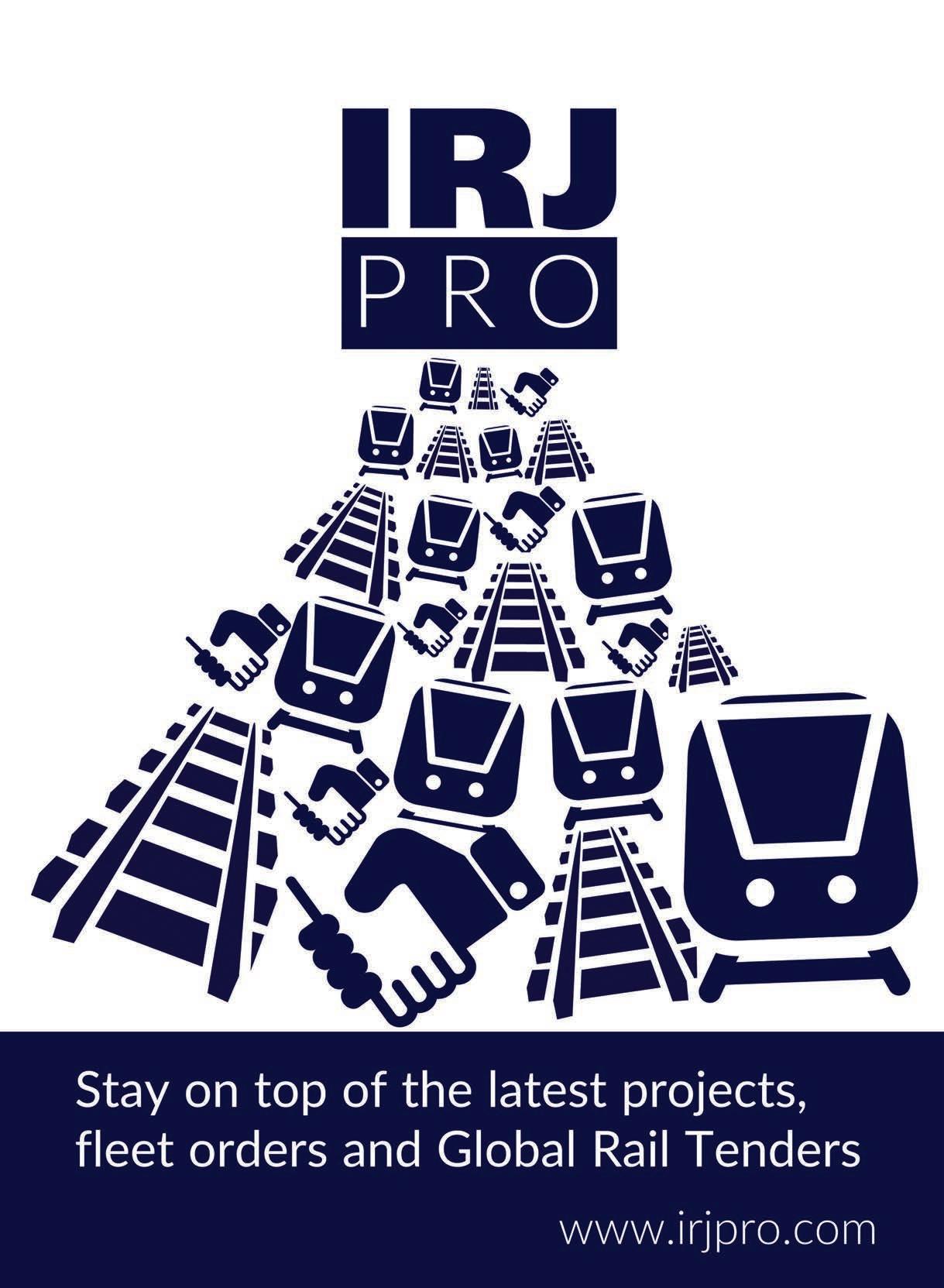




NEXT
RAILWAY EDUCATIONAL BUREAU
RAILWAY EQUIPMENT CO
SA RAIL
THERMON INC



We Must Continue to ‘Meet the Moment’
Every n ew Administration begins its tenure with a wave of activity. This time around, POTUS 47’s “unique” style combined with a change of party control in Congress has turned that expected wave into a tsunami. I am pleased to say that short line railroads have met the moment in an admirable fashion and on many fronts.
Since January, short lines have presented oral testimony at three Congressional Hearings—Pinsly Railroad General Counsel and ASLRRA Executive Committee member Kristin Bevil before the House T&I Committee on ways to improve the CRISI grant process, Anacostia Rail CEO Peter Gilbertson before the Senate Commerce Committee on modernizing the rail network, and yours truly before the House T&I on the need for continuing federal infrastructure investment and short line priorities in surface transportation reauthorization.
Immediately after the new Session of Congress began, short lines started soliciting Congressional signatures on letters to the House and Senate Appropriations Committees urging full funding for the CRISI grant program. In short order they secured signatures from 62 House Members and 31 Senators. Although the FY2026 appropriations process is yet to be finished, the House Appropriations Committee has advanced its version of the bill that includes $538.4 million for CRISI, up significantly from the $100 million enacted in FY2025. This funding is in addition to the $1 billion in advance CRISI appropriations approved by the previous Congress.
In May, ASLRRA hosted one of the best attended Railroad Day on Capitol Hill events ever, with 305 Congressional meetings held by 327 well-prepared and engaged attendees from across the country. One of the primary missions was to secure co-sponsors for the short line 45G rail rehabilitation tax credit modernization bills.
In addition, short lines have participated in a half dozen state specific fly-ins to build our 45G co-sponsor list. These combined efforts have resulted in more than 400 short line representatives holding more than 500 Congressional meetings in the first six months of the year. This work has now yielded 96 co-sponsors for the House bill (H.R.516) and 13 co-sponsors for the Senate bill (S.1532).
While this is more co-sponsors than the vast majority of bills introduced in the new Congress (we’re in the 97th percentile already), we know from past experience that our success in enacting 45G legislation depends on our ability to secure a majority of the 435 House and 100 Senate Members. There is a long road ahead on that front, and 99th percentile is more fun than 97th percentile anyway.
With the able assistance of an active ASLRRA Surface Transportation Board (STB) Working Group, ASLRRA General Counsel Sarah Yurasko has spearheaded an effort to secure STB process and policy changes that will benefit the short line industry. The effort piggybacks on STB Chairman Fuchs’s policy review initiative, which is seeking to streamline agency procedures, improve collaboration and transparency, and ensure a more efficient and effective regulatory environment. We are seeking three changes that will save short lines time and money and level the playing field with our modal competitors.
First, short line railroads spend valuable time and resources asserting federal preemption in state and federal courts in matters where there is clearly preemption. We are asking the STB to provide more aggressive and anticipatory leadership in helping educate states, localities, federal entities, and courts about the extent of ICC Termination Act (ICCTA) preemption.
The STB took on the task effectively in commenting on CARB’s Section 209(E) Authorization Request for its In-Use Locomotive Regulation. This type of
proactive work is crucial in protecting short lines’ ability to compete with trucks for business.
Second, short lines need an accelerated process for the formal recognition of common carrier status. Because there is no established process, other than through a lengthy STB declaratory order proceeding, for new carriers to provide local government agencies or the courts proof of that status, short lines are often forced to spend significant amounts of time and money on legal proceedings predicated on third parties and/or local government challenging the carrier’s STB-regulated common carrier status.
Third, in 2006 the STB made a regulatory change that unnecessarily lengthened the period for class exemption procedures from seven days to 30 days. Delays cost money and kill deals and are a regulatory invitation for competitive modes of transportation not so regulated to fill the transportation void and grab competitive business.
A real tsunami will change the landscape it hits in an instant and there is little anyone can do about that. Today’s political tsunami has indeed changed the landscape in an instant, but short lines have proven there is much we can do to respond.
I am deeply appreciative of the thousands of hours that short line representatives have spent meeting with and educating Members of Congress and transportation agency decision-makers on the issues that are so important to short line success. What progress we have made in the past six months is a direct result of that time and effort. I cannot stress enough how important it is that short lines continue that work.


Mechanical Department Regulations

FRA News:
The FRA released several final rules covering many Parts that went into effect in July. Among them, the FRA is making clarifying changes to better align with FRA’s safety jurisdiction and to conform definitions in FRA’s older regulations with the definition of ‘‘person’’ that FRA has used in its most recent rulemakings. In one section where ‘‘person’’ is defined, FRA is also replacing references to specific penalty amounts with general references to FRA’s minimum civil monetary penalty, ordinary maximum civil monetary penalty, and aggravated maximum civil monetary penalty amounts, consistent with FRA’s current practice.

Other final rules made various administrative updates to several FRA regulations, including updating addresses in those regulations.
Please review the effective dates on this page for the Part you are interested in.

Part 213: Track Safety Standards
49 Part 213, Subparts A-F. Classes of Track 1 through 5: Applies to track required to support passenger and freight equipment at lower speed ranges. Includes Defect Codes and Appendices A, B, and C to Part 213. Softcover. Spiral bound. Updated 7-1-25.
BKTSSAF Track Safety Standards $13.95
Order 50 or more and pay only $12.50 each

Part 214: Railroad Workplace Safety
The FRA’s Railroad Workplace Safety standards address roadway workers and their work environments. Subparts A-General, B-Bridge Worker Safety Standards, C-Roadway Worker Protection, D-On-Track Roadway Maintenance, and Defect Codes for Part 214. Spiral bound. Updated 7-1-25
BKWRK Railroad Workplace Safety $13.95
Order 50 or more and pay only $12.50 each

Bridge Safety Standards
FRA Part 237 establishes Federal safety requirements for railroad bridges. This rule requires track owners to implement bridge management programs, which include annual inspections of railroad bridges if the weather or other conditions warrant such inspections, and to audit the programs. Part 237 also requires track owners to know the safe load capacity of bridges. Updated 7-1-25
BKBRIDGE Bridge Safety Standards $14.00
Order 50 or more and pay only $12.60 each
HIGH CAPACITY I PRECISION I RELIABILITY
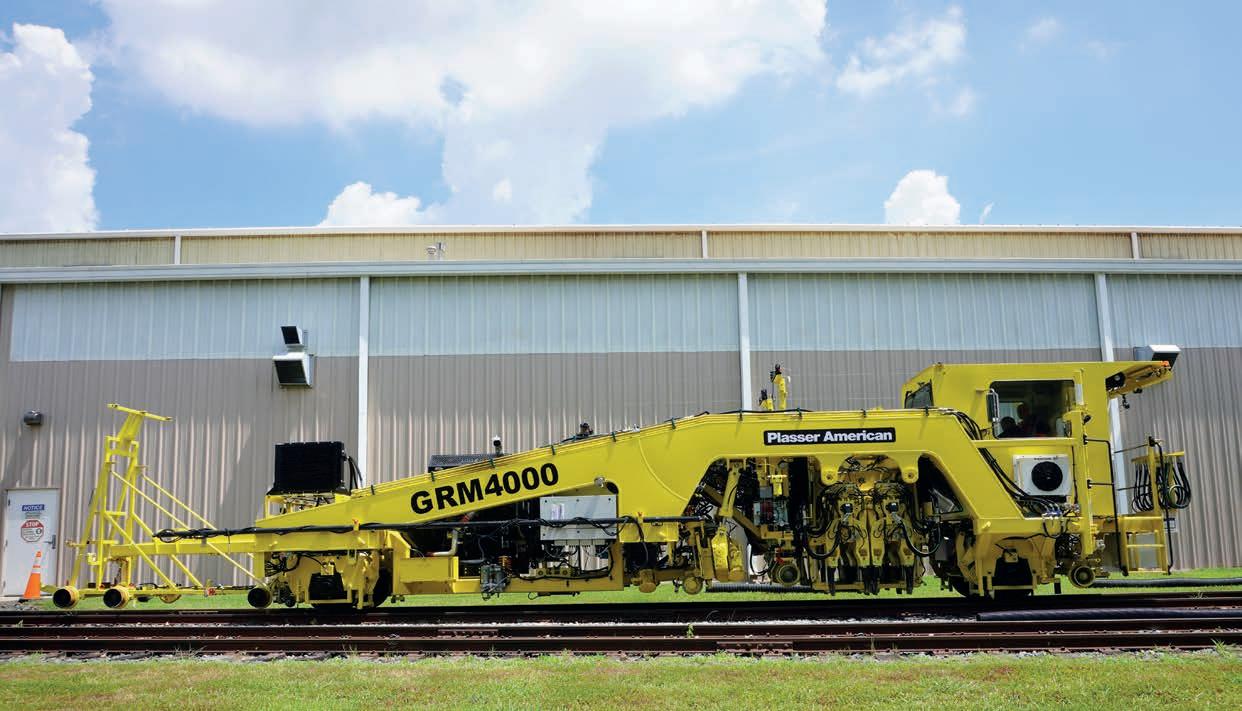
Proven Technology with Advanced Performance
Meet the GRM4000 : a heavy-duty, high - performance production & switch tamping machine with a double-tie unit. Enhanced throughput, up to 3,400 ft/hr reduces crew needs with the option to attach an autonomous stabilizer. Its ergonomic controls, AGGS & ATLAS automation, and smart weight distribution for road or rail transport, the GRM4000 delivers precision and peak efficiency. Upgrade to tomorrow’s tamping today.

